#frank fair game 1988
Note
🌹 🌹🌹
I'm gonna cheat and give a sentence from three WIP instead of three sentences from one because I'm hyped on all of them.
Frank grinned against the shell of her ear, unable to stop the sense of pride that came with each soft mewl that left the omega as his fingers continued to tease. (Alpha Frank x Omega reader)
The raspy, grizzled voice of the older man was the only thing keeping you tethered to reality; grounding you in a way that let the desire to scream, to cry, to throw things fade into the background. (Norman Nordstrom x reader)
"Afternoon, Stuart," you greeted the older man cheerfully, clearly catching him off guard as he visibly startled. (Stuart Lloyd x reader)
#frank fair game 1988#frank x reader#wip game#fair game 1988#norman nordstrom x reader#norman nordstrom#slasher writing#horror writing#slasher x reader#stuart Lloyd#stuart lloyd x reader#the last showing#don't breathe#bill moseley characters#stephen lang characters#robert englund characters#i'm writing smut and it's actually coming out decent and not making me want to hurl my tablet? i'm just as shocked as everyone else
25 notes
·
View notes
Photo

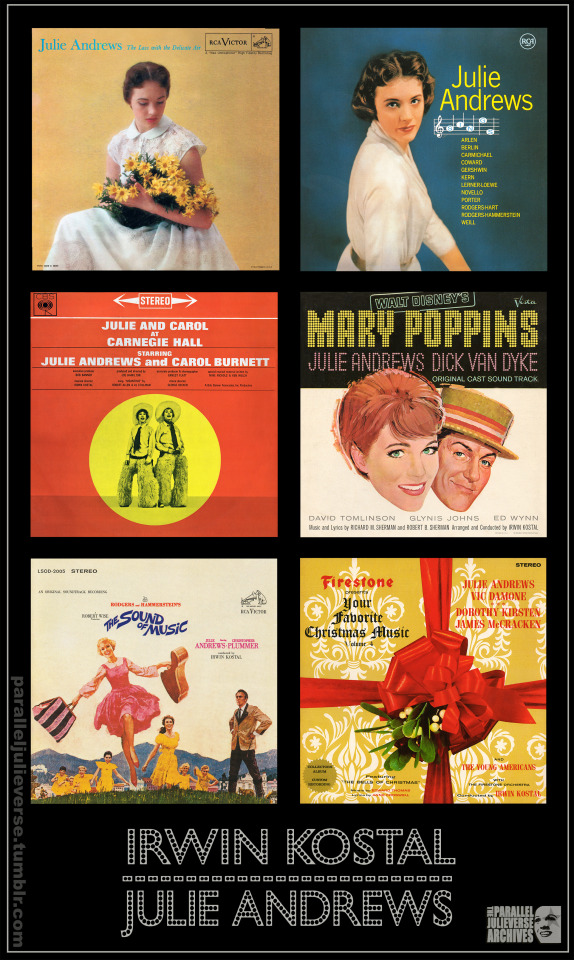

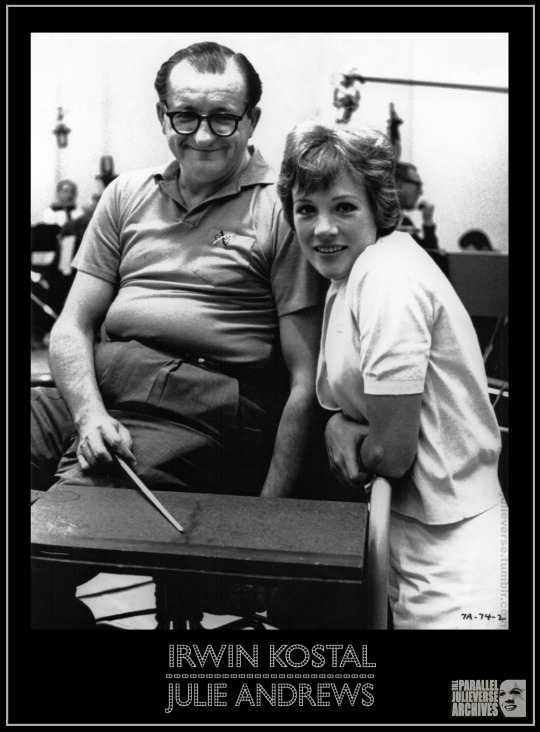
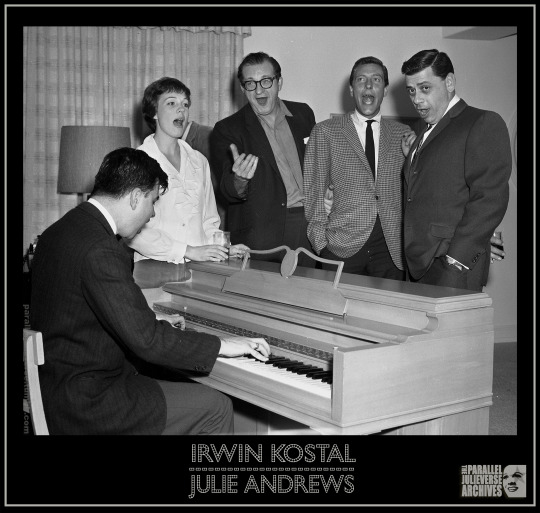

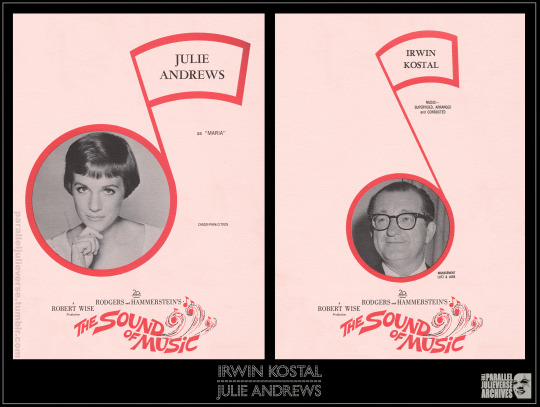
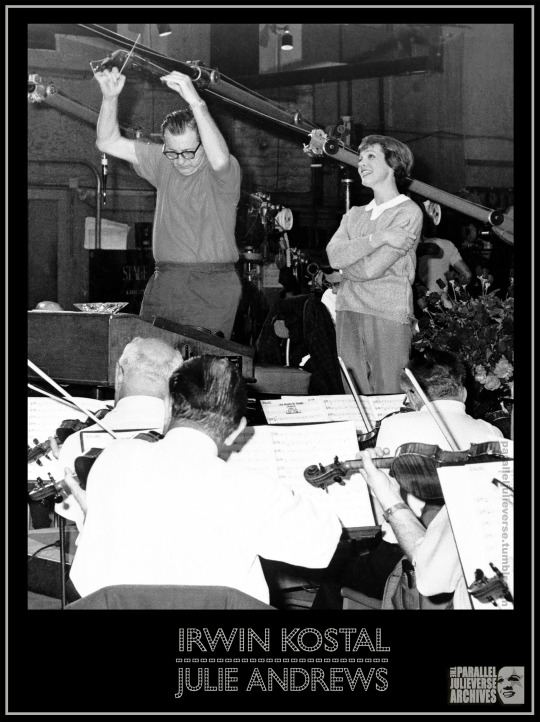

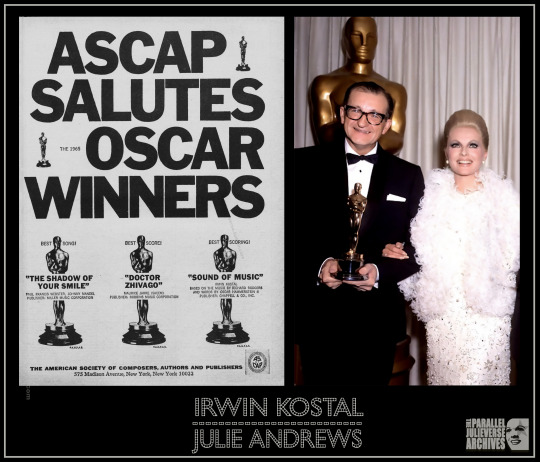
‘Gentlemen like you are few...’: A Supercentenary Tribute to Irwin Kostal
1 October 2021 marks the 110th anniversary of the birth of Irwin Kostal, the musical arranger, orchestrator and conductor whose work helped shape the sound of the post-war American stage and screen musical. In this post we look back at the career of this remarkable 'music man’ with a particular focus on his collaborations with the equally remarkable Julie Andrews -- who, as it happens, shares the same birthday, so this post is doing double birthday honours.
A gentle, unassuming man, Kostal or ‘Irv’ as he was known by associates, was not one for the limelight. It’s possibly why he gravitated to the ‘behind-the-scenes’ art of musical arranging. Unlike composers, performers, or even conductors, arrangers seldom loom large in public perceptions of professional musicianship. They are, for the most part, the ‘invisible artists’ of the music industry: their contributions to the sound and experience of music are immense, but they remain largely ‘uncredited in records, liner notes or books or records’ (Niles 2104, p. 4). That Irwin Kostal would ultimately prove a rare exception to this tradition of thankless anonymity -- becoming sufficiently well-known to have his own name not only included on recordings, but emblazoned on the front cover alongside those of the ‘star’ vocalists with whom he worked -- is a testament to the singularity of his talents.
Born the son of first generation immigrant parents in Chicago in 1911, Kostal claimed he was instantly ‘smitten’ by music when he saw a piano at the age of two-and-a-half, but his family was too poor to afford such luxuries. Moreover, his father -- a hard-drinking Czech with a fiery temper -- was ‘rigidly opposed’ to his interests in music and ‘could see no future in it’ (’Irwin’ 1962, p. 70). So Kostal initially had to content himself with listening and absorbing as much musical knowledge as he could indirectly. When he was eleven, his father finally brought home a broken player piano salvaged from a removals job and it provided the young Kostal with the launch pad he needed.
Kostal devoted himself to his musical education with single-minded zeal. His formal training was intermittent -- enabled by a supportive mother who ‘surreptitiously managed to save money from her weekly allowance for my musical instruction’ (’Irwin’ 1962, p. 70) -- but he was a passionate autodidact who would spend countless hours studying and practising on his own. By age 15, he was already playing professionally with local touring bands, while also offering his own services as a piano teacher with, at one point, more than 40 pupils (ibid.).
When he wasn’t playing, Kostal would be found in the local library poring over musical scores and reading about the greats of the classical canon. He was particularly intrigued by orchestration and the possibilities it offered for varying the sound and feel of music. He recalls how he would take orchestral scores home and study all the parts learning ‘about musical instruments I never knew existed’ (Suskin 2009, p. 56). He progressively worked his way through the music of the masters, going alphabetically:
‘Bach...Beethoven, Brahms, Debussy, Elgar, Frank, Gounod, on and on through the alphabet...I tried to absorb everything. By the time I came to Ravel, Tchaikovsky and Wagner, I knew quite a lot about music in a jumbled way’ (Suskin 2009, p. 57).
While still in his teens, Kostal started to experiment with arrangements of his own, scoring a high school production of Uncle Tom’s Cabin with multiple variations on the American folk melody ‘Way Down upon the Swanee River’. ‘By taking away the rhythmic aspects and playing it in a minor key,’ he recounts, ‘I found lots of ways to play this song, making it fit the dramatics of the half-hour long story’ (ibid., p. 56). Thus, Irwin Kostal the arranger was born.
Throughout the 1930s and early-40s, Kostal honed his talents in a professional capacity, working with various big bands, before finally landing a job as a resident arranger for an NBC radio affiliate in Chicago. Following the war, Kostal moved to New York where, after a rocky start, he secured regular work as conductor and arranger on a number of long-running radio and TV variety shows including Your Show of Shows (1950-54), Max Liebman Presents (1954-56), and The Garry Moore Show (1959-63). It was demanding, fast-paced work with Kostal having to arrange and orchestrate hundreds of score pages a week, but it consolidated his musical versatility and capacity to work across a wide range of styles and forms (Suskin 2009, pp. 57-60).
Throughout this period, Kostal was also orchestrating for Broadway shows, racking up over 52 credits on theatre productions big and small (Allen 1995, p. 18). Many of these assignments were done in a ‘ghost-writer’ capacity including contributing work to such classic musicals as Wonderful Town (1953), The Pajama Game (1953) and Silk Stockings (1955). A major breakthrough came when Kostal was contracted to work in a credited capacity as co-orchestrator on the original Broadway production of West Side Story (1958) -- collaborating with Leonard Bernstein, Stephen Sondheim and Sid Ramin. It earned him his first Grammy Award and a subsequent invitation to arrange and orchestrate a string of other big Broadway musicals including Fiorello! (1959), Sail Away (1961) and A Funny Thing Happened on the Way to the Forum (1962).
The success of West Side Story also saw Kostal do repeat honours on the film version (1961) which would, in turn, earn him an Academy Award and kickstart a hugely successful Hollywood career. In 1963, Kostal was invited by none other than Walt Disney to take on the major job of arranging the songs for Mary Poppins (1964) which had been written by the in-house Disney composing team of Richard M. and Robert B. Sherman. The Sherman Brothers claim to have suggested Kostal because they were fans of his Broadway work and they wanted a bright theatrical sound for the score. However, Walt Disney demurred. He reasoned it was a period film and they needed someone who could write music for any style or era, suggesting they get the musical director from The Garry Moore Show instead. Cue mutual delight when it was discovered they were all referring to the same man, Irwin Kostal (Sherman & Sherman 1998; Suskin 2009, p. 65).
Kostal’s work on Mary Poppins catapulted him to new heights of mainstream success. It not only secured him another Academy Award nomination -- he lost to Andre Previn for his work on My Fair Lady -- but it also brought him a tidy fortune in royalties from the film’s best-selling soundtrack album (’Kostal’s’ $65,000′, 57). His fame -- and fortune -- skyrocketed even further the following year when Kostal was contracted to arrange the score for The Sound of Music (1965). His dazzling efforts on this box-office blockbuster confirmed Kostal’s status as Hollywood’s presiding musical wonder-boy and saw him walk home with his second Oscar. A string of other big screen musicals followed including Half a Sixpence (1967), Chitty Chitty Bang Bang (1968) and Bedknobs and Broomsticks (1971).
Many of these films were repeat collaborations because Kostal favoured working with people he knew and with whom he clicked personally and creatively. He would for example continue as the de facto ‘house’ arranger for Disney well into the 1980s, working on various assignments for the studio including Pete’s Dragon (1978), Mickey’s Christmas Carol (1983) and the controversial re-recorded 1982 release of Fantasia (1940/1982) (Tietyan 1990). Kostal would also maintain a long association with the Sherman Brothers, acting as musical arranger for all their big screen musicals including the aforementioned Chitty Chitty Bang Bang (1968) and Bedknobs and Broomsticks (1971), as well as Tom Sawyer (1973); Charlotte’s Web (1973); and The Magic of Lassie (1978) (Sherman & Sherman 1998).
The other great collaboration of Kostal’s career was of course with Julie Andrews. Perhaps it was the fact that the pair shared the same birthday but Kostal had an extraordinarily sympathetic relationship with Julie and he would work with her more than any other vocalist. Long before they teamed on Poppins and The Sound of Music, Julie and ‘Irv’ were making musical magic together. Kostal was the arranger and conductor for Julie’s first two solo albums for RCA: The Lass with the Delicate Air (1957) and Julie Andrews Sings (1958) where his sensitive facility with a wide range of musical idioms from English classical to Broadway and Tin Pan Alley came to the fore. Reviewing the first of these albums at the time of its original release, one music critic lauded it as ‘a record to charm every member of the family...[with] a combination of sincerity and simplicity and wholesome sweetness...Thank goodness arranger and conductor Irwin Kostal met the challenge and set the ballads winningly without overpowering Miss Andrews’ light pure tones’ (RRS 1958, p. 5A). In a similar vein, another reviewer praised the second album for ‘its charming unforced version of standards, well known and almost forgotten...Miss Andrews still sings naturally and purely [and] the deft accompaniments played by an orchestra under Irwin Kostal are agreeably restrained’ (Masters 1959, p. 11).
In this early period Kostal also worked with Julie as guest star on several episodes of The Garry Moore Show, where he was resident musical director. In this context, Kostal was pivotal in helping establish the legendary teaming of Julie and Carol Burnett which came out of the Garry Moore appearances. He would go on to act as musical director for their breakout 1962 TV special Julie and Carol at Carnegie Hall which would earn Kostal his first Emmy (Taraborelli 1988, pp. 172-79). He would secure his second Emmy a few years later working with Julie again on the 1965 variety special, The Julie Andrews Show (1965) where, among other highlights, Kostal scored a series of stellar song-and-dance medleys for Julie and guest star Gene Kelly. The same year, Kostal teamed up with Julie on yet another recording with the 1965 edition of the annual Firestone Christmas albums.
It was however their combined work on the two big musical mega-hits, Mary Poppins and The Sound of Music, that secured the Kostal-Andrews partnership a place in the history books. A cultural phenomenon of the highest order, the soundtrack recordings for these two films remain among the most successful albums of all time. Mary Poppins held the #1 spot on the US national music charts for 14 consecutive weeks in 1964, beating out Elvis Presley and The Beatles (Hollis and Erhbar 2006, pp.72ff). The album for The Sound of Music sold over 9 million copies in its first four years of release alone, remaining in the Billboard Top 100 for an unbelievable five-and-a-half years, and becoming the highest selling LP of all-time in the US up to that date (Murrells, 1978) The Sound of Music continued its record-breaking run abroad, dominating the international charts and holding the #1 spot for 75 weeks in Australia, 73 weeks in Norway and 70 weeks in the UK, becoming in the process the single biggest selling album worldwide of the 1960s (Harker, 1992, pp. 189-91).
Commentators have frequently singled out the combination of Julie Andrews’ soaring vocals and Kostal’s dynamic arrangements as instrumental to the phenomenal success of these two albums. ‘Miss Andrews glows--positively glows--right through the record groove, vinyl disc, amplifiers, speakers, and all other mechanical barriers,’ enthused one contemporary reviewer of the Mary Poppins soundtrack, noting how the ‘songs that Richard M. and Robert B. Sherman have written’ and ‘the handsome arrangements by Irwin Kostal have the perfect balance ‘of lilt and flair to provide Miss Andrews with an effective working basis’ (Wilson 1965, p. 109). Apropos The Sound of Music, another critic pronounced it ‘as good a reproduction of a score as has ever been made’, noting how it ‘presents Julie in a most appealing role and given the splendid musical direction of Irwin Kostal, her talent comes shining through...as a treat beyond measure’ (Moore 1965, p. B6).
In total, Julie Andrews and Irwin Kostal would work together on six recordings, two musical motion pictures, two television specials, and a host of other TV appearances representing some of the very best of Julie’s musical work during her heyday of the 1960s. Considered alongside the wealth of Kostal’s other work across film, stage, television and recording, it’s hard not to concur with Disney’s Nelson Meecham who, on the occasion of Kostal’s passing in 1994, eulogised: ‘He brought the joy of music to more people than it is possible to count’ (Allen, p. 19).
Sources:
Allen, John F 1995. ‘Remembering a Music Man: On the life and work of Irwin Kostal.’ Boxoffice. August: pp. 18-19.
Harker, Dave 1992. ‘Still Crazy After All These Years: What was popular music in the 1960s?” Cultural Revolution? The challenge of the arts in the 1960s. Bart Moore-Gilbert and John Seed, eds. Routledge, London and New York: pp. 186-200.
Hollis, Tim and Erhbar, Greg 2006. Mouse Tracks: The Story of Walt Disney Records. Jackson: University Press of Mississippi.
‘Irwin Kostal: Music in all its many forms is his life.’ (1962). The Province. 2 June: p. 70.
’Kostal’s’ $65,000 Poppins Score’ 1965. Variety. 10 March: p. 57
Levy, Charles 1964. Mary Poppins: About the stars and photo-story features [Press kit]. Buena Vista Distribution, New York.
Masters, John 1959. ‘Off the Record: Enchanting Music.’ The Age. 7 January: p. 11.
Moore, Robert 1965. ‘Record Turntable: Julie Andrews out in front again in film album of”Sound of Music”.’ The Arizona Daily Star. 7 March: p. B6.
Murrells, Joseph, ed. 1978. Book of Golden Discs: Records that sold a million. Barrie & Jenkins, New York.
Niles, Richard 2014. The Invisible Artist: Arrangers in popular music (1950-2000). BMI, London.
Oliver, Myrna. 1994. ‘Obituaries: Irwin Kostal; Film, TV Orchestrator.’ The Los Angeles Times. 1 December: P. B8.
RRS 1958. ‘On the Record: ‘Lass with the Delicate Air.’ Bristol Herald Courier. 9 February: p. 5A.
Sherman, Robert B & Sherman, Richard M 1998. Walt's Time: From before to beyond. Camphor Tree, Santa Clarita, CA.
Suskin, Steven 2009. The Sound of Broadway Music: A book of orchestrators and orchestrations, Oxford University Press, New York.
Taraborelli, J. Randy 1988. Laughing Till It Hurts: The complete life and career of Carol Burnett. William Morrow & Co, New York.
Tietyan, David 1990. The Musical World of Walt Disney. H. Leonard, Milwaukee, Wis.
Wilson, John S. 1965. ‘The Lighter Side’. High Fidelity Magazine. 15: 4: pp. 107-111.
© 2021, Brett Farmer. All Rights Reserved.
#julie andrews#irwin kostal#musicals#classic film#the sound of music#mary poppins#Disney#Sherman Brothers
20 notes
·
View notes
Text
Mike Bossy, R.I.P

When you think of hockey legends, especially in my home state of New York, one name absolutely comes to mind. A name that has cemented itself in mythological legend status. That name is Michael Dean Bossy, or as we know him here in Long Island, Mike Bossy.
Mike Bossy was born on January 22nd, 1957 in Montreal, Quebec, Canada. Growing up a hockey fan, you would think his family would root for the hometown heroes of hockey, the Montreal Canadiens. However, this was not the case, as everyone in his family cheered for the Detroit Red Wings. As a youth, Bossy played in the 1969 Quebec International Pee-Wee Hockey Tournament with a minor ice hockey team from Montreal. He started his junior career with the Laval National of the Quebec Major Junior Hockey League at the age of 15.
Bossy, who had averaged 77 goals per season, playing in junior hockey leagues, was passed over by twelve teams in the 1977 NHL Draft. Despite scoring 309 goals in five seasons, he was considered "not rugged enough" and defensively weak by NHL scouts. Teams such as the New York Rangers and the Toronto Maple Leafs, casted this shadow of doubt. Even his hometown Montreal Canadiens passed on him, but later regretted that decision.
The New York Islanders picked Bossy with the 15th overall selection and the rest, as they say, is history. Literally. Mike Bossy went on to have one of the most storied careers in NHL history. Not only was he a huge contributor to the Stanley Cup dynasty of the Islanders, but Bossy had impressive numbers. He scored 573 goals and had 553 assists in only 752 games. In 129 playoff games, he had eighty-five goals and seventy-five assists. When he retired, he held the record for most goals per season average with 57.3. Bossy was also noted for his clean play and won the Lady Byng Trophy for gentlemanly play three times in 1983, 1984, and 1986. Bossy officially retired in October 1988, having played his last game at the age of 30, due to back pain that had been plaguing him in the latter half of his career.
As of 2022, Bossy holds or shares the following NHL records:
-Most consecutive 50+ goal seasons: 9
-Most 50+ goal seasons (not necessarily consecutive): 9 (tied with Wayne Gretzky and Alexander Ovechkin)
-Most 60+ goal seasons (not necessarily consecutive): 5 (tied with Wayne Gretzky)
-Highest goals-per-game average, career (minimum 200 total goals): .762 goals per game
-Most power-play goals, one playoff season: 9 (tied with Cam Neely)
-Most consecutive hat tricks: 3 (tied with Joe Malone, who accomplished this twice)
-In January 2017, Bossy was named one of the '100 Greatest NHL Players' in history
Mike Bossy also led the league in goals twice, in 1978–79 and 1980–81. He was inducted into the Hockey Hall of Fame in 1991 and his No. 22 was retired by the Islanders on March 3, 1992.

I will be fair in saying that, I do not come from a family of hockey fans. Okay, I'll be even more frank, black people just don't watch hockey. I am the only exception, and maybe my grandpa, but that's only because he hates all sports teams from Boston, including the Bruins, then later, he developed resentment towards the Pittsburgh Penguins because of Mario Lemieux's unflattering comments he made about Long Island and the fanbase. Naturally, I took to my grandpa's same feelings. At a young age, when I could finally comprehend the channels of sports fandom and rivalries on Long Island, several names began to resonate with me. Names such as Lawrence Taylor, Don Mattingly, Patrick Ewing, Mike Tyson, with regards to what my household was watching and who was the hometown hero we all rallied behind.
As I was coming into my own, understanding who and what I was cheering for, 1993 is when I turned my attention to the New York Islanders. That is also the year I attended my first hockey game at Nassau Coliseum. This was an awesome time, especially since food and tickets were not that pricey. The fanbase, rugged, colorful and passionate. I am not exaggerating when I tell you, the only time I've seen cops and dudes off the street corners actually get along and smile at each other was at an Islanders game. I remember looking up in the rafters, seeing the blue, orange and white banners and all the pageantry that went along with it.

For some odd reason, one name stood out. I remember asking someone, "Hey, who's Bossy?" and the response I got was, "You mean Mike Bossy. He's retired, but he's a f--kin' legend here!"
Then, I knew where I stood. While I became enamored with the legend, Mike Bossy, and the stories I've heard, especially regarding his offensive abilities and what I've been able to view later on in life from old hockey footage on YouTube and NHL.com, I still feel like the Islanders and Mike Bossy don't get the recognition or respect they rightfully earned. Even if you casually watch the game or hate the Islanders, any hockey fan would agree, the New York Islanders were good. Very good. Bossy agreed as well. Even with the impressive dynasty built in the 80's and the Islanders impressive playoff runs, Bossy harbored some animosity towards other teams & players getting more attention, especially Wayne Gretzky and the Edmonton Oilers, whom they swept in the Stanley Cup championship of 1983. Bossy stated in an interview in Sports Illustrated magazine that the Islanders got little recognition for their dynasty compared to their rivals. Bossy complained "I do a lot of promoting for how good [the Islanders] were … We never got one millionth of the recognition we should. We had a very low-key organization. They didn't want guys doing too much, because they thought the hockey might suffer. People don't talk about us in the first mention of great teams."
The mentions in sports documentaries & hall of fame recognition still doesn't do this impressive run enough justice.
When I think of the Islanders, and how I became a fan, there were these contributing factors; First, I am from Long Island (duh!). Secondly, my grandpa's beer-infused hatred for rival cities and anyone that bad-mouthed New York or Long Island. Third, the miracle of 1993, when the Islanders shocked the world by knocking off the defending Stanley Cup champs, Pittsburgh Penguins in the 1st round of the playoffs and defying all expectations of critics and fans. Lastly, a guy from Montreal, passed over by powerhouse franchises in the National Hockey League, drafted by a barely new team from Long Island still searching for identity & respect, wore the number 22 and carried a region of New York to hockey greatness.
Mike Bossy. Thank you and God bless.

2 notes
·
View notes
Text
what Classic Film(TM) you should watch based on who your fave Danganronpa 1/2 character is
disclaimer - obviously as a film dude i’m gonna say you should watch all of these. but maybe watch the one correlating to your fave first!
Makoto: 12 Angry Men (1957, dir. Sidney Lumet) - strong themes of justice, it’s about a jury trying to determine a man’s guilt. it’s basically what Makoto does for the entire game. you’ll also like it if you’re a fan of Phoenix Wright.
Sayaka: A Star is Born (1954, dir. George Cukor) - it’s all about a girl’s rise to fame and how her relationships change with that. there’s three versions of this film, most recently with Lady Gaga.
Mukuro: Vertigo (1958, dir. Alfred Hitchcock) - themes of murder and hiding your identity, losing yourself to a cause.
Leon: Animal House (1978, dir. John Landis) - a comedy about a fraternity. it’s THE college frat movie and i think Leon would enjoy it a lot.
Chihiro: WarGames (1983, dir. John Badham) - two teenagers might have accidentally started a world war during the cold war by trying to play computer games...fitting for the series, no?
Mondo: On the Waterfront (1954, dir. Elia Kazan) - struggling to do the right thing and being sort of frustrated about your circumstances as they pertain to class and missed opportunities. being dragged into bad situations by family. also Marlon Brando is a bicon and very hot in this movie.
Taka: Rebel Without a Cause (1955, dir. Nicholas Ray) - a lot of turbulent shit happens to three teenagers over the course of 24 hours. one of - if not the first canonically gay teenager on film. i think we all know by now that James Dean was mlm, but so were the director and Sal Mineo. big bi polyam vibes; if you like chishimondo as a ship you’ll probably like this film too.
Hifumi: Akira (1988, dir. Katsuhiro Otomo) - had a hard time figuring out what to put for Hifumi, but overall i think if nothing else he’d appreciate how impressive the animation was (and honestly, still is) along with the fact that the mangaka was also the director. so although there’s a lot cut out (the manga had not finished before the film came out), it’s still roughly the same plot as the manga.
Celes: Dracula (1931, dir. Tod Browning) - probably the most iconic iteration of Bram Stoker’s novel, this is the one staring Bela Lugosi. not terribly true to the novel from what i remember, but it’s peak aesthetic and exactly the kind of thing she’d enjoy.
Sakura: Rashomon (1950, dir. Akira Kurosawa) - finally getting onto films i haven’t actually seen but that are on my list. sakura’s another person i had a hard time deciding on a film for, but the “several characters telling different accounts of the same plot” reminded me a bit of her case in the game.
Hina: West Side Story (1961, dir. Robert Wise & Jerome Robbins) - admittedly i had a different film in mind for her to start with, but Maria’s final monologue fits with Hina’s motivations during Sakura’s case.
Toko: Gone With the Wind (1939, dir. Victor Fleming) - another one i haven’t actually watched yet, but it’s based on a famous novel, described as “epic historical romance.” i think that vibes with Toko pretty well.
Byakuya: Citizen Kane (1941, dir. Orson Welles) - if you’re really interested in film, you’re gonna be made to watch this sooner or later. famous for being the “best film ever made”, it’s more or less about newspaper moguls like William Randolph Hearst - who is also the main reason why this film is famous at all. it’s not exactly a flattering depiction of those kinds of people and boy, did that ever piss Hearst off. if he hadn’t made such a big deal trying to keep Citizen Kane from seeing the light of day, something much better might have made it to the top spot.
Hiro: The Music Man (1962, dir. Morton DaCosta) - based on the Broadway musical of the same name, a “travelling salesman” (read: con artist) starts to work his latest con on a gullible small town, but actually starts liking the people in it.
Kyoko: The Man Who Knew Too Much (1956, dir. Alfred Hitchcock) - not to be confused with the other Hitchcock film from the 30s also titled The Man Who Knew Too Much. this is the one with James Stewart and Doris Day. it’s a highly suspenseful film that gave us the song “Que Sera, Sera (Whatever Will Be, Will Be)”.
Junko: Gaslight (1944, dir. George Cukor) - ever heard the term “gaslighting”? this is where it comes from! based on a play in which a woman’s husband psychologically tortures her into believing she is going insane.
Monokuma: Duck Soup (1933, dir. Leo McCarey) - all Marx Brothers films are as utterly silly (and sometimes as incomprehensible) as one of Monokuma’s MonoTheatres. i watched about half of Duck Soup and had to stop because it was finals week and i was supposed to be doing something other than losing my shit.
Hajime: It’s a Wonderful Life (1946, dir. Frank Capra) - you probably already know this film. if you’re Christian you know it as That Film Your Parents Watch Every Year On Dec 24th Around Midnight. if you have seasonal depression, don’t watch it then; warning for suicidal ideation. it’s supposed to be uplifting. your mileage may vary on that one.
Impostor: To Kill a Mockingbird (1962, dir. Robert Mulligan) - i don’t have a good reason to pair these two up other than gut feeling. as far as film adaptations of books go, it’s pretty damn good, and Atticus Finch is the original DILF. themes of childhood innocence and racism.
Teruteru: Breakfast at Tiffany’s (1961, dir. Blake Edwards) - apparently much different from the novella on which it is based, but i think Teruteru would really dig the aesthetic and romantic vibes of the film. Holly Golightly is probably the original Manic Pixie Dream Girl.
Mahiru: Rear Window (1954, dir. Alfred Hitchcock) - like It’s a Wonderful Life, chances are good you know this film - or at least, you’ve seen its plot recycled a hell of a lot. a professional photographer recovering from a broken leg thinks he witnesses a murder take place and is determined to get to the truth.
Peko: Seven Samurai (1954, dir. Akira Kurosawa) - another one on my to-watch list, but it’s oft referenced and remade in film. a village hires seven ronin to protect them from bandits who will return to steal their crops.
Hiyoko: East of Eden (1955, dir. Elia Kazan) - i’ll be honest here, i didn’t really know what to put for Hiyoko because i’m not sure i understand much about her, but i seem to remember her family playing a pretty big role in her being Like That and for “shitty family” the first two things to come to mind were this and Giant. and unless you like 3-hour long movies about the state of Texas, i’m not about to recommend you watch Giant.
Ibuki: A Night at the Opera (1935, dir. Sam Wood) - another Marx Bros film in which they help a girl both to be with her lover and to achieve her dreams of stardom as an opera singer. the kind of silly, manic thing i think Ibuki would like.
Mikan: The Shining (1980, dir. Stanley Kubrick) - i hate hate hate putting this on here, but since this is for film and not books i couldn’t exactly state to read the book. the book is about the cycle of abuse. the movie is more about... a trapped man going crazy in a spooky hotel.
Nekomaru: It’s a Mad, Mad, Mad, Mad World (1963, dir. Stanley Kramer) - comedy about five groups of people racing to get to a large sum of money buried by a recently escaped convict they stopped to help out after his car crash. it’s a comedy, and just kinda seemed like Nekomaru’s thing.
Gundham: The Seventh Seal (1957, dir. Ingmar Bergman) - i watched this in like 10th grade and all i really remember is a man playing chess with Death and if that doesn’t say Gundham Tanaka to you, i don’t know what does.
Nagito: North by Northwest (1959, dir. Alfred Hitchcock) - i don’t really have a reason for this one either but it’s a spy film and i think komaeda could get behind that kind of intrigue.
Chiaki: Metropolis (1927, dir. Fritz Lang) - not to be confused with the anime, this is a 1927 German expressionist film that seems to be about socialism and unionization. it’s also famous for its (purposeful) use of the Male Gaze and being one of the first sci-fi films ever made. be warned: it is a silent film.
Sonia: Strangers on a Train (1951, dir. Alfred Hitchcock) - another one of those films you’ll get told to watch if you’re interested in the queer history of film, i was gonna put something else but honestly the character of Barbara kinda reminded me of Sonia. a famous tennis player meets a man on a train who attempts to plan a double-murder with him.
Akane: My Fair Lady (1964, dir. George Cukor) - i was trying so hard not to double up on the post about musicals, but Akane really does have Eliza Doolittle vibes. they’re both feral and nothing would be able to really domesticate them. for whatever it’s worth, this film and the musical on which it is based is itself based on the play Pygmalion, in which your typical rich cishet white dude bets he can turn any street urchin into a real lady because he’s just that good. you might know the plot better as Pretty Woman.
Kazuichi: A Streetcar Named Desire (1951, dir. Elia Kazan) - i don’t really have a good excuse for this one, either; i haven’t even watched it yet (although i have read the play on which it is based). all i’m gonna say is i want Souda to have his gay awakening via Marlon Brando, as we all do.
Fuyuhiko: Casablanca (1942, dir. Michael Curtiz) - despite his love and adoration for Ingrid Bergman, Humphrey Bogart decides fighting Nazis is more important. i think Fuyuhiko would like the aesthetic, and the film. don’t let him know but i think he’d probably cry watching it.
Usami: To Sir, With Love (1967, dir. James Clavell) - issues of race and class intersecting in a film about a teacher working with inner city students. i was going to put Singin’ in the Rain here, because it’s what Usami would want people to watch...but i think this better fits the effect she wants to have as a being.
#plato posts#danganronpa#ok to rb#makoto naegi#kiyotaka ishimaru#nagito komaeda#chihiro fujisaki#leon kuwata#sayaka maizono#byakuya togami#kyoko kirigiri#mukuro ikusaba#mondo oowada#hifumi yamada#celes ludenberg#yasuhiro hagakure#sakura oogami#aoi asahina#toko fukawa#junko enoshima#monokuma#hajime hinata#chiaki nanami#monomi#kazuichi souda#gundham tanaka#fuyuhiko kuzuryu#peko pekoyama#hiyoko saionji#mahiru koizumi
97 notes
·
View notes
Text
A Strong and Loving World

WATCHMEN #12
OCTOBER 1987
BY ALAN MOORE, DAVE GIBBONS AND JOHN HIGGINS

SYNOPSIS (FROM DC DATABASE)
Midnight, November 2, 1985.
Most of New York City has been devastated by the psychic trauma caused by the instant death of Ozymandias' "alien."
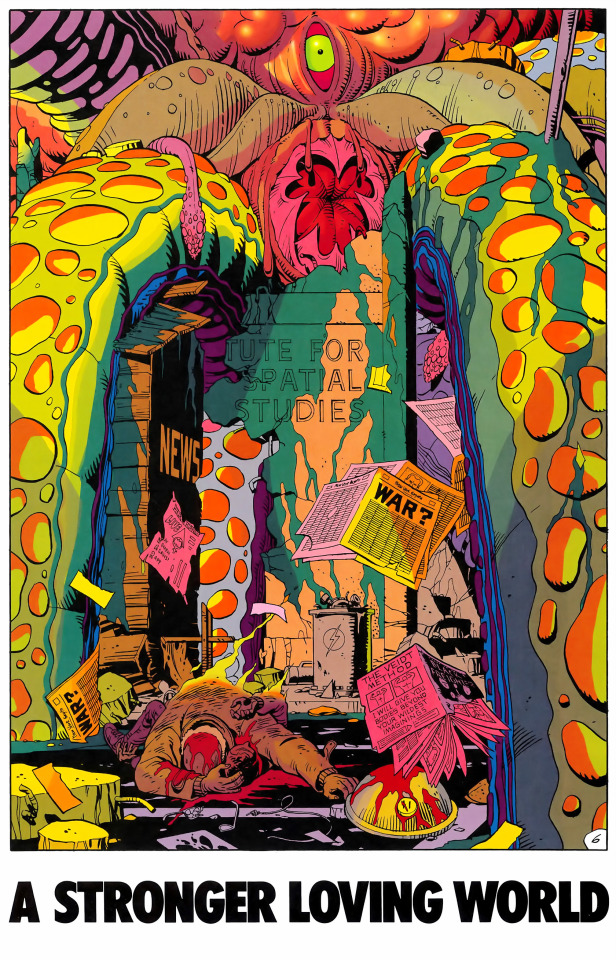
Dr. Manhattan and a heavily distraught Laurie arrive in the city too late as they tour the devastation. After they have seen enough, the two teleport away to the South Pole, to follow a trail of tachyon particles that Dr. Manhattan senses will lead to the source of the disturbance. Before they left, Laurie picks up a gun from the deceased Detective Steven Fine.
At Karnak, Ozymandias continues to detail his plan to Rorschach and a disbelieving Nite-Owl. He explains he cloned the brain of the dead psychic Robert Deschaines and having it augmented and programmed with horrible visions and concepts of aliens, so that the mental transmissions given off at its death would affect anyone around it who managed to survive the initial psychic blast. Thus forcing humanity to cast aside their petty enmities and focus on a common alien enemy. But to ensure this plan to work, Veidt necessarily eliminated anyone involved in his plan. Although Veidt admits he hasn't any ideas what he will do with Rorschach and Nite-Owl.
Manhattan and Laurie soon arrives to Karnak, where Manhattan confront Veidt. Veidt hinders Manhattan with a tachyon generator that interferes with Doctor Manhattan's ability to see the future, and then disintegrates him in an intrinsic field subtractor at the regrettable cost of Veidt's pet Bubastis. This act is witness by Laurie, who then shoots Veidt with Fine's gun. However, Veidt use his newfound, and untried, ability to catch the bullet. After subduing Laurie, Veidt begins to lecture the costumed heroes that their "obvious heroism" is redundant and that their failure to prevent "Earth's salvation" will usher a new era for humanity. But his speech is cut short when to Veidt's surprise, Manhattan restores himself. Before Manhattan could pass judgement on Veidt, the world's smartest man make one last trick by showing everyone news broadcasts of the aftermath of the disaster in New York, which has cost the lives of over two million people, which has prompt an end to hostilities between the U.S. and Soviet Union and calling for peaceful cooperation against Veidt's faked alien threat.
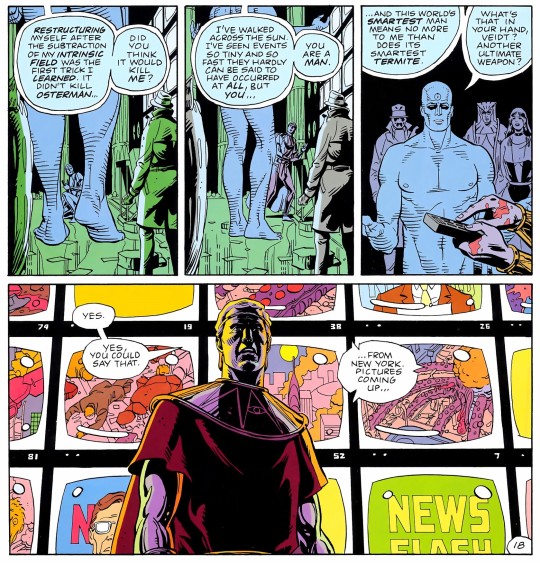
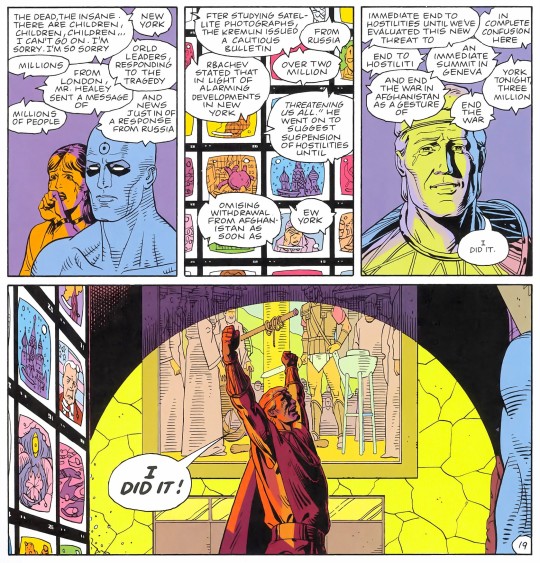
Veidt revels in his victory for bringing Earth into a "utopia" and convinces almost everyone present that exposing the truth would bring a permanent end to world peace. Manhattan, Laurie, and Dan reluctantly agree to concealing Veidt's truth. But Rorschach refuses to compromise with keeping the secret and proceed to leave despite Dan's pleas. Veidt is seemingly unconcerned of Rorschach being a "reliable witness" before retiring to meditate in his ornery and offering Dan and Laurie a stay in his home. Laurie and Dan found a private room to reflect on their decision and they settle down to make love.


Outside, Rorschach tries to start up his hoverbike but is stop by Manhattan. Rorschach takes off his mask, knowing that Veidt's new utopia is to be protected with the cost of his own life and prompts Manhattan to reluctantly disintegrate him. Manhattan walks back inside the retreat, where he finds Dan and Laurie asleep together and smiles at Laurie's newfound love and happiness and walks out of the room to meet Veidt. The two discuss about Veidt's well-intention reasons for ensuring world peace at the cost of millions of human lives. Veidt is surprise that Manhattan regained interest in human life, to which Manhattan suggests that he may "create some [human life]" in another galaxy that he will be travelling to. But before Manhattan could go, Veidt ask him if his plan worked out in the end. Manhattan smiles and enigmatically replies that "nothing ever ends." Veidt is left totally confuse by Manhattan's words and appears to be in doubt as to whether or not his plan was successful.


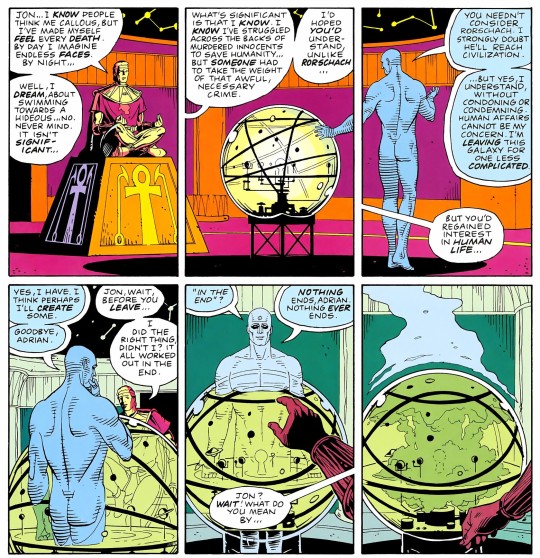
Sometime during Christmas, Laurie and Dan, who have assumed new identities, visit Sally Jupiter. Laurie tells Sally that she knows Edward Blake is her real father. She explains to her mother that she understands the complex relationship between Sally and Blake and that she has comes to terms with that. Laurie and Dan soon leaves while indicating that they would continue to adventure, although Laurie expressed the wish for a better superhero identity, a more protective leather outfit, a mask, and a firearm much like The Comedian.
In New York that which has been recovering from the disaster, the editor at New Frontiersman, Hector Godfrey, complains about having to pull a two-page column about Russia due to the new political climate. He asks his assistant Seymour to find some filler material from the "crank file", a collection of rejected submissions to the paper, to write. Sitting on top of the pile of discarded submissions is Rorschach's journal.
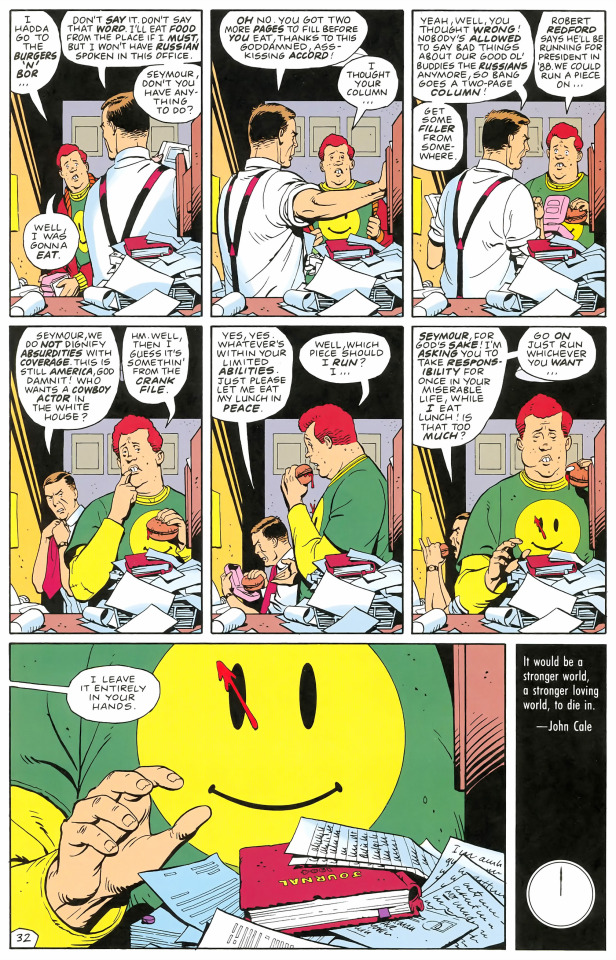

CRITICAL RECEPTION (FROM WIKIPEDIA)
Watchmen was first mentioned publicly in the 1985 Amazing Heroes Preview. When Moore and Gibbons turned in the first issue of their series to DC, Gibbons recalled, "What really clinched it [...] was [writer/artist] Howard Chaykin, who doesn't give praise lightly, and who came up and said, 'Dave what you've done on Watchmen is fuckin' A.'" Speaking in 1986, Moore said, "DC backed us all the way [...] and have been really supportive about even the most graphic excesses". To promote the series, DC Comics released a limited-edition badge ("button") display card set, featuring characters and images from the series. Ten thousand sets of the four badges, including a replica of the blood-stained smiley face badge worn by the Comedian in the story, were released and sold. Mayfair Games introduced a Watchmen module for its DC Heroes Role-playing Game series that was released before the series concluded. The module, which was endorsed by Moore, adds details to the series' backstory by portraying events that occurred in 1966.
Watchmen was published in single-issue form over the course of 1986 and 1987. The limited series was a commercial success, and its sales helped DC Comics briefly overtake its competitor Marvel Comics in the comic book direct market. The series' publishing schedule ran into delays because it was scheduled with three issues completed instead of the six editor Len Wein believed were necessary. Further delays were caused when later issues each took more than a month to complete. One contemporaneous report noted that although DC solicited issue #12 for publication in April 1987, it became apparent "it won't debut until July or August".
After the series concluded, the individual issues were collected and sold in trade paperback form. Along with Frank Miller's 1986 Batman: The Dark Knight Returns miniseries, Watchmen was marketed as a "graphic novel", a term that allowed DC and other publishers to sell similar comic book collections in a way that associated them with novels and dissociated them from comics. As a result of the publicity given to the books like the Watchmen trade in 1987, bookstore and public libraries began to devote special shelves to them. Subsequently, new comics series were commissioned on the basis of reprinting them in a collected form for these markets.
Watchmen received critical praise, both inside and outside of the comics industry. Time magazine, which noted that the series was "by common assent the best of breed" of the new wave of comics published at the time, praised Watchmen as "a superlative feat of imagination, combining sci-fi, political satire, knowing evocations of comics past and bold reworkings of current graphic formats into a dystopian mystery story". In 1988, Watchmen received a Hugo Award in the Other Forms category.
OWNERSHIP DISPUTES (FROM WIKIPEDIA)
Disagreements about the ownership of the story ultimately led Moore to sever ties with DC Comics. Not wanting to work under a work for hire arrangement, Moore and Gibbons had a reversion clause in their contract for Watchmen. Speaking at the 1985 San Diego Comic-Con, Moore said: "The way it works, if I understand it, is that DC owns it for the time they're publishing it, and then it reverts to Dave and me, so we can make all the money from the Slurpee cups." For Watchmen, Moore and Gibbons received eight percent of the series' earnings. Moore explained in 1986 that his understanding was that when "DC have not used the characters for a year, they're ours." Both Moore and Gibbons said DC paid them "a substantial amount of money" to retain the rights. Moore added, "So basically they're not ours, but if DC is working with the characters in our interests then they might as well be. On the other hand, if the characters have outlived their natural life span and DC doesn't want to do anything with them, then after a year we've got them and we can do what we want with them, which I'm perfectly happy with."
Moore said he left DC in 1989 due to the language in his contracts for Watchmen and his V for Vendetta series with artist David Lloyd. Moore felt the reversion clauses were ultimately meaningless because DC did not intend to let the publications go out of print. He told The New York Times in 2006, "I said, 'Fair enough,' [...] 'You have managed to successfully swindle me, and so I will never work for you again.'" In 2000, Moore publicly distanced himself from DC's plans for a 15th anniversary Watchmen hardcover release as well as a proposed line of action figures from DC Direct. While DC wanted to mend its relationship with the writer, Moore felt the company was not treating him fairly in regards to his America's Best Comics imprint (launched under the WildStorm comic imprint, which was bought by DC in 1998; Moore was promised no direct interference by DC as part of the arrangement). Moore added, "As far as I'm concerned, the 15th anniversary of Watchmen is purely a 15th Anniversary of when DC managed to take the Watchmen property from me and Dave [Gibbons]." Soon afterward, DC Direct cancelled the Watchmen action-figure line, despite the company having displayed prototypes at the 2000 San Diego Comic-Con International.
LEGACY (FROM WIKIPEDIA)
A critical and commercial success, Watchmen is highly regarded in the comics industry and is frequently considered by several critics and reviewers as comics' greatest series and graphic novel. In time, the series has also become one of the best-selling graphic novels ever published. Watchmen was the only graphic novel to appear on Time's 2005 "All-Time 100 Greatest Novels" list, where Time critic Lev Grossman described the story as "a heart-pounding, heartbreaking read and a watershed in the evolution of a young medium." It later appeared on Time's 2009 "Top 10 Graphic Novels" list, where Grossman further praised Watchmen, proclaiming "It’s way beyond cliché at this point to call Watchmen the greatest superhero comic ever written-slash-drawn. But it’s true." In 2008, Entertainment Weekly placed Watchmen at number 13 on its list of the best 50 novels printed in the last 25 years, describing it as "The greatest superhero story ever told and proof that comics are capable of smart, emotionally resonant narratives worthy of the label 'literature'." The Comics Journal, however, ranked Watchmen at number 91 on its list of the Top 100 English-language comics of the 20th century.
In Art of the Comic Book: An Aesthetic History, Robert Harvey wrote that, with Watchmen, Moore and Gibbons "had demonstrated as never before the capacity of the [comic book] medium to tell a sophisticated story that could be engineered only in comics". In his review of the Absolute Edition of the collection, Dave Itzkoff of The New York Times wrote that the dark legacy of Watchmen, "one that Moore almost certainly never intended, whose DNA is encoded in the increasingly black inks and bleak storylines that have become the essential elements of the contemporary superhero comic book," is "a domain he has largely ceded to writers and artists who share his fascination with brutality but not his interest in its consequences, his eagerness to tear down old boundaries but not his drive to find new ones." Alan Moore himself said his intentions with works like Marvelman and Watchmen were to liberate comics and open them up to new and fresh ideas, thus creating more diversity in the comics world by showing the industry what could be done with already existing concepts. Instead it had the opposite effect, causing the superhero comic to end up stuck in a "depressive ghetto of grimness and psychosis". In 2009, Lydia Millet of The Wall Street Journal contested that Watchmen was worthy of such acclaim, and wrote that while the series' "vividly drawn panels, moody colors and lush imagery make its popularity well-deserved, if disproportionate", that "it's simply bizarre to assert that, as an illustrated literary narrative, it rivals in artistic merit, say, masterpieces like Chris Ware's 'Acme Novelty Library' or almost any part of the witty and brilliant work of Edward Gorey".
Watchmen was one of the two comic books, alongside Batman: The Dark Knight Returns, that inspired designer Vincent Connare when he created the Comic Sans font.
In 2009, Brain Scan Studios released the parody Watchmensch, a comic in which writer Rich Johnston chronicled "the debate surrounding Watchmen, the original contracts, the current legal suits over the Fox contract".
In September 2016, Hasslein Books published Watching Time: The Unauthorized Watchmen Chronology, by author Rich Handley. The book provides a detailed history of the Watchmen franchise.
In December 2017, DC Entertainment published Watchmen: Annotated, a fully annotated black-and-white edition of the graphic novel, edited, with an introduction and notes by Leslie S. Klinger (who previously annotated Neil Gaiman's The Sandman for DC). The edition contains extensive materials from Alan Moore's original scripts and was written with the full collaboration of Dave Gibbons.
THE FILM
There are three versions of the Watchmen movie. The theatrical (that I watched several time at cinemas, including IMAX), a director’s cut (includes an extra half hour of movie) and the Ultimate Cut, which includes all the Black Freighter scenes.
I would recommend the theatrical version. I recently watched the ultimate version and the Black Freighter scenes do not work with the movie and also do not work with its altered ending. Hollis Mason’s death scene also feels even more disconnected to the story.
But even the theatrical version... I would say... I do not recommend you to watch it if you haven’t read the novel. The movie is a piece of beauty, visually, but the script feels a lot like they tried very hard to keep the original dialogues, and every time they change something you notice, because something feels out of place (even if you are watching it with fresh eyes).
REVIEW
What else can I add?
As a fan, I find it uneasy that only Gibbons can enjoy the credit for this story in all the adaptations, as Moore does not want to be mentioned in any of those (instead, they always say “co-created by Dave Gibbons”). It makes me feel dirty for buying the book a couple of times, and watching the movies (also V for Vendetta).
But beyond that, this is a piece of art, a very sophisticated piece of art. It’s what comics should aspire to be. Not every comic-book should... but I would love seeing something like this more often.
The series was made with great level of detail. To the point where you can spend minutes on pages or panels, finding things. In this last issue, the first look at New York, after the peace accord, is a whole new world full of details that tell you a story. This is why Watchmen is the perfect graphic novel, and has so much problem being adapted to other mediums or even having prequels and sequels. It was designed in a way that makes sense in these 12 issues of visual entertainment, where writing and art tell a complete story, but wouldn’t be the same if you had a novelization of it.
It was made for comic-books. You could do an adaptation to film with the same level of detail, but you wouldn’t be able to enjoy it, pausing to find all the details in every frame. Instead, they would have to find a new way of adapting this highly detailed and three-dimensional world.
I recommend buying the “Watchmen Annotated” edition as well, as a supplementary book to the regular one (or absolute, depending which version you have).
I give Watchmen a score of 10, and you should read it at least twice before you die.
#alan moore#dave gibbons#john higgins#dc comics#comics#review#1987#modern age#doctor manhattan#rorschach#nite owl#silk spectre#ozymandias#bubastis#world war iii#new frontiersmen#vertigo comics
9 notes
·
View notes
Text
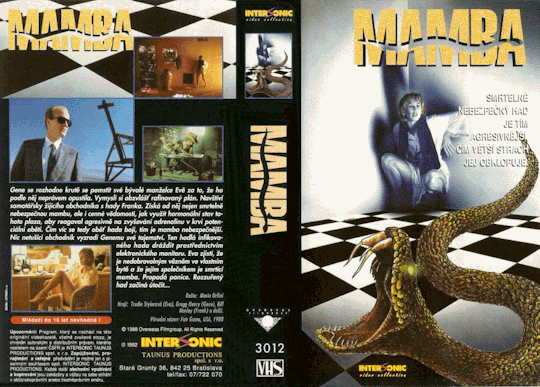
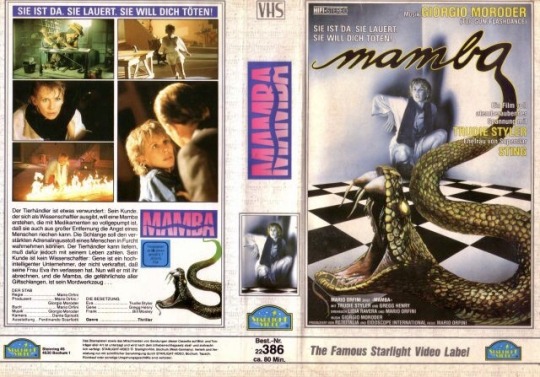
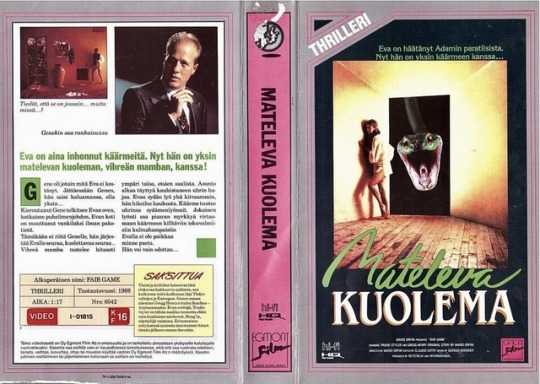
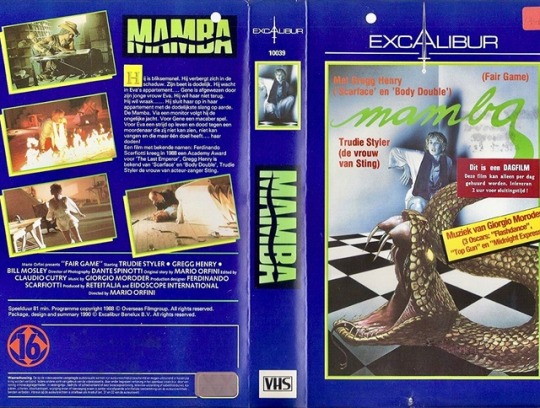
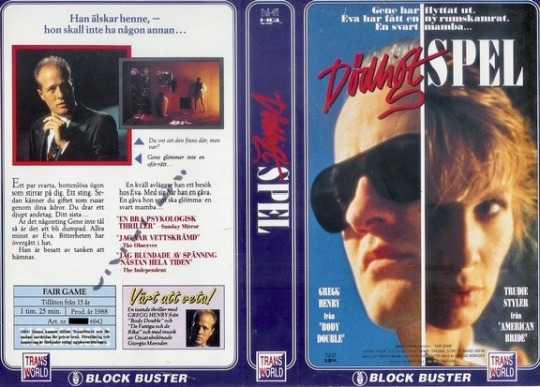

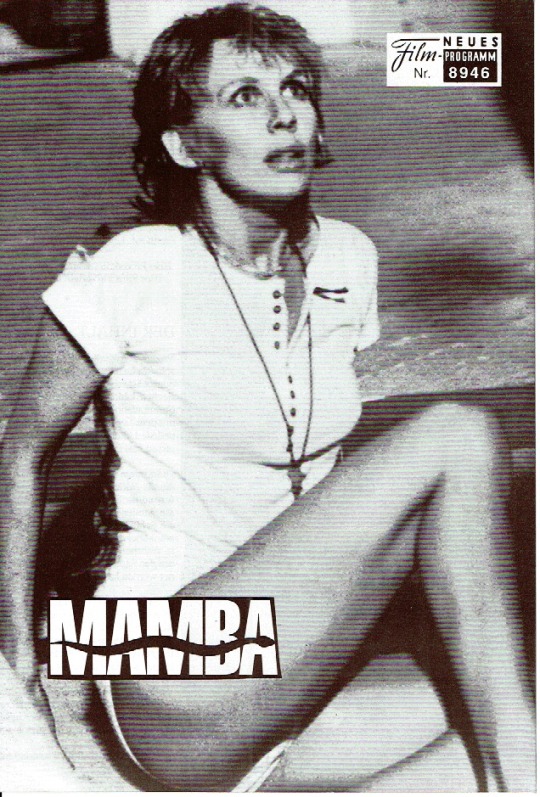


1988
Mamba (1988 film) aka Fair Game (1988 film)
Data di uscita: 1988 in Cinema 28 aprile 1989
Regista: Mario Orfini
Musiche Giorgio Moroder
Fotografia di scena Helmut Newton
Sceneggiatura: Mario Orfini, Lidia Ravera
Candidature: David di Donatello per il miglior scenografo
ART POSTER DEL MAESTRO Renato Casaro
Interpreti e personaggi
Trudie Styler: Eva
Gregg Henry: Gene
Bill Moseley: Frank
Curiosità
L'intero cast del film è composto da sole cinque persone: i due protagonisti, il procacciatore di serpenti, un passante e l'annunciatore televisivo.
Inizialmente le musiche dovevano esser composte da Peter Gabriel ma successivamente venne scelto Giorgio Moroder
Produzione
Il budget del film si aggirava attorno ai 4,6 milioni di dollari.
La lavorazione durò dieci settimane e gli interni vennero girati tutti negli studi di Cinecittà nel Teatro Tre,mentre altre scene vennero girate a Los Angeles e nel deserto del Mojave.
Durante la produzione il film cambiò varie volte il nome, da Mamba a No exit, ed infine Fair Game, il titolo statunitense.
Orfini decise di utilizzare dei mamba veri, e la produzione ne fece arrivare cinque dall'Africa equatoriale; i serpenti vennero sistemati in una gabbia di vetro riscaldata a 40 gradi.
Ogni venti giorni i mamba venivano nutriti con dei topolini bianchi.
Ai mamba vennero estratte delle ghiandole velenifere, ma questo si rivelò dannoso nei confronti dei serpenti stessi.
A causa di ciò vennero usati dei giovani pitoni ai quali veniva applicato del cerone per renderli più somiglianti ai mamba.
In tutto i serpenti erano tre, uno nero, uno grigio e uno beige.
Una delle difficoltà fu anche che i serpenti avvertivano la paura della Styler, e questi si bloccavano.
Inoltre si cercava di non stressare eccessivamente i pitoni, per cui le riprese venivano interrotte spesso. Durante le riprese due degli esemplari morirono a causa della fatica.
Per riprodurre i movimenti del mamba, Orfini usò la tecnica della steadicam.
Nella sua autobiografia, Luciano De Crescenzo ha narrato un aneddoto particolare del film: nella sceneggiatura originale era previsto che il Mamba avrebbe mangiato realmente un coniglio, ma alcuni membri della troupe non vollero che questa scena si girasse e chiamarono l'Ente Nazionale Protezione Animali. Il regista, tuttavia, approfittando della lontananza di costoro (che, nel frattempo, si erano recati al bar) girò lo stesso la scena che però ebbe un risvolto imprevisto: grazie ai suoi rapidi movimenti, fu il coniglio ad uccidere il serpente.
Gli animalisti del set brindarono all'evento ma lo scrittore napoletano li criticò: pur essendo anche lui contrario a quel crudo assassinio, non approvava il fatto che gli animali fossero divisi in "simpatici" e "antipatici"
Botteghino
Il film non fu un successo in Italia, anche perché fu realizzato specificatamente per il pubblico americano. Mamba venne distribuito nel circuito cinematografico italiano nei primi giorni del maggio 1989 e incassò 539.521.000 lire.
Gli incassi del primo giorno provenienti da Roma e Milano vennero devoluti all'Amazzonia.
Il film durante la prima messa in onda su Italia1 ottenne dei buoni risultati con 3 milioni di ascolti.
Il film ebbe maggior successo all'estero, infatti la società Overseas vendette il film a 36 paesi, tra cui 27 copie furono vendute da Orfini.
#mamba#mamba 1988#mario orfini#trudie styler#gregg henry#bill moseley#giorgio moroder#fair game#horror movies#film horror#italian horror#horror film#80s horror#horrormovie#giallo fever#giallofever#italian cult#cult#italian giallo#cinema cult#italian sexy comedy#international cult#gialli#giallo
3 notes
·
View notes
Text
Updated! Big List of Spooky Movies and Books!
Get ready for Halloween~
I’m a notorious list-maker; I love collecting stories, and I also love sharing them with people who are either looking for ref or just want to find something interesting. “Spooky” is a pretty broad term, so I listed different categories below that will hopefully make more sense. Some movies/books fit into more than one category, so I picked one and stuck it there. Some stories have a film and book version that are both worth taking a look at, so I put a *by those titles (and they appear in the movie and book list). These range from being for kids to more mature, so if that is a concern for you be sure to check out the rating/content yourself
I’ve updated this since I’ve added a few more titles to my collection, and added more categories (but I think I’ll call this done for now, I can’t update it every couple of months)
I wanted to limit myself, at least a little (otherwise the list would have gon on forever). So each category has at least 3 titles listed, but no more than 7. A few of these are more funny than scary, and some might not really be “spooky” at all, but they still fit the theme. Something to keep in mind, I only listed stories that I own. This is not a complete list or a “best of”. I went with the ones from my personal collection because I know them best and I enjoy them. Hopefully I listed a few that will help somebody with research, or at least entertain them for a bit!
Enjoy~
Halloween
Movies- Hocus Pocus (1993), *the Halloween Tree (1993), the Nightmare before Christmas (1993), Trick r Treat (2007), Monster House (2006), Halloweentown (1998), the Legend of Sleepy Hollow (1949)
Books- How to Drive Your Family Crazy on Halloween by Dean Marney,*the Halloween Tree by Ray Bradbury, the Haunted Mask (Goosebumps) by RL Stine, Dark Harvest by Norman Partridge
Ghosts
Movies- Poltergeist (1982), the Haunting (1999), Casper (1995), Ghostbusters (1984), the Haunted Mansion (2003), Thirteen Ghosts (2001), *the Muppet Christmas Carol (1992)
Books- Stonewords a Ghost Story by Pam Conrad, Deep and Dark and Dangerous by Mary Downing Hahn, Ghost Beach (Goosebumps) by RL Stine, the Crossroads by Chris Grabenstein, Wait Till Helen Comes by Mary Downing Hahn, *a Christmas Carol by Charles Dickens
Witch
Movies- *Practical Magic (1998), *the Wizard of Oz (1939), *the Witches (1990), Kiki’s Delivery Service (1989), Scooby-Doo and the Witch’s Ghost (1999) *Harry Potter and the Sorcerer’s Stone (2001), the Craft (1996)
Books- *Practical Magic by Alice Hoffman, *the Witches by Roald Dahl, Charmed Life by Diana Wynne Jones, the Unwilling Witch by David Lubar, *Harry Potter and the Sorcerer’s Stone by JK Rowling, *the Wizard of Oz by L Frank Baum
Vampire
Movies- Blade (1998), the Little Vampire (2000), Hellboy Blood and Iron (2007), Hotel Transylvania (2012), Fright Night (2011)
Books- Bunnicula by James and Deborah Howe, Dracula by Bram Stoker, ‘Salem’s Lot by Stephen King
Werewolf
Movies- Alvin and the Chipmunks meet The Wolfman (2000), Ginger Snaps (2000), Van Helsing (2004) Wolf Children (2012), the Wolfman (1941)
Books- Wolfen by Whitley Strieber, Red Rider’s Hood by Neal Shusterman, the Werewolf of Fever Swamp (Goosebumps) by RL Stine
Zombies
Movies- Scooby-Doo on Zombie Island (1998), ParaNorman (2012), Night of the Living Dead (1968), *Pet Cemetery (1989), Zombieland (2009), Resident Evil (2002), Dawn of the Dead (2004)
Books- *Pet Cemetery by Stephen King, the Haunting of Derek Stone by Tony Abott, Welcome to Dead House (Goosebumps) by RL Stine
Demons/Devil/Possession
Movies- the Omen (1976), Insidious (2010), the Exorcist (1973), *Christine (1983), Fallen (1998), *Rosemary’s Baby (1968), Bedazzled (2000)
Books- *Christine by Stephen King, Needful Things by Stephen King, On the Devil’s Court by Carl Deuker, HECK where the bad kids go by Dale E Bayse,* Rosemary's Baby by Ira Levin
Curse/Transformation
Movies- *Beauty and the Beast (1991), the Princess and the Frog (2009), Penelope (2006), Kubo and the two strings (2016), the Swan Princess (1994), the Thing (1982), the Mummy (1999)
Books- *Beauty and the Beast translated by Richard Howard and illustrated by Hilary Knight, the Witch’s Boy by Michael Gruber, Owl in Love by Patrice Kindl, the Invasion (Animorphs) by KA Applegate
Monsters
Movies- Monsters Inc (2001), Eight Legged Freaks (2002), Godzilla (1998), *a Monster Calls (2016), Pokemon the First Movie (1998), *Jurassic Park (1993), King Kong (1933)
Books- *a Monster Calls by Patrick Ness, Frankenstein by Mary Shelley, *Jurassic Park by Michael Crichton
Cryptids and Mythology
Movies- Harry and the Hendersons (1987), Darkness Falls (2003), Atlantis the lost empire (2001), Song of the Sea (2014), *the Last Unicorn (1982), Urban Legend (1998), Tall Tale (1995)
Books- Sasquatch by Roland Smith, *the Last Unicorn by Peter S Beagle, the Moor Child by Eloise Jarvis McGraw, the Lightning Thief (Percy Jackson and the Olympians) by Rick Riordan
Giants/Tiny Folk
Movies- Honey I Blew Up the kid (1992), the Borrowers (1997), Mickey and the Beanstalk (1947), *Thumbelina (1994), the Princess Bride (1987), Gulliver’s Travels (1939), *Horton Hears a Who (2008)
Books- *Horton Hears a Who by Dr Seuss, Fairy Haven and the Quest for the Wand by Gail Carson Levine, Trouble with Trolls by Jan Brett, *Thumbelina (Hallmark pop-up book)
ESP/Psychic/Mental Powers
Movies- *Carrie (1976), *Firstarter (1984), *Matilda (1996), the Last Mimzy (2007)
Books- *Carrie by Stephen King, *Firestarter by Stephen King, *Matilda by Roald Dahl, Scorpion Shards (Star Shards Chronicles) by Neal Shusterman
Dolls and Toys
Movies- *Coraline (2009), the Adventures of Pinocchio (1996), Child’s Play (1988), Toy Story (1995), 9 (2009)
Books- Frozen Charlotte by Alex Bell, *Coraline by Neil Gaiman, No Flying in the House by Betty Brock
Circus/Carnival/Fair
Movies- We’re Back a dinosaur’s story (1993), the Care Bears Movie (1985), Little Nemo adventures in Slumberland (1989), *Something Wicked This Way Comes (1983), *Charlotte’s Web (1973), Dumbo (1941)
Books- Joyland by Stephen King, *Something Wicked This Way Comes by Ray Bradbury, *Charlotte’s Web by EB White
Gothic
Movies- the Others (2001), the Addams Family (1991), Rebecca (1940), Edward Scissorhands (1990), Mama (2013)
Books- the Raven by Edgar Allen Poe, the Shining by Stephen King, Remember Me by Mary Higgins Clark
Dark Fantasy
Movies- Legend (1985), the Dark Crystal (1982), *the Princess and the Goblin (1991), Labyrinth (1986), *the Neverending Story (1984), *the Secret of NIMH (1982), Anastasia (1997)
Books- Well Witched (Verdigris Deep) by Frances Hardinge, Poison by Chris Wooding, *the Neverending Story by Michael Ende, *Mrs Frisby and the Rats of NIMH by Robert C O'Brien, Zel by Donna Jo Napoli, *the Princess and the Goblin by George MacDonald, a Tale Dark and Grimm by Adam Gidwitz
Dragons
Movies- *How to Train Your Dragon (2010), the Pagemaster (1994), Mulan (1998), the Flight of Dragons (1982), Shrek (2001), *the Hobbit (1977), Quest for Camelot (1998)
Books- *How to Train Your Dragon by Cressida Cowell, Jeremy Thatcher Dragon Hatcher by Bruce Coville, *the Hobbit by JRR Tolkien
Other Worlds
Movies- Spirited Away (2001), *Alice in Wonderland (1951), Space Jam (1996), the Book of Life (2014), *Hook (1991), Pleasantville (1998), *the Phantom Tollbooth (1970)
Books- *Peter Pan by JM Barrie, Malice by Chris Wooding, * the Phantom Tollbooth by Norton Juster, *Alice’s Adventures in Wonderland by Lewis Carroll
Mystery/Thriller
Movies- Clue (1985), *Holes (2003), Get Out (2017), Hot Fuzz (2007), Minority Report (2002), Kidnap (2017), Saw (2004)
Books- *Holes by Louis Sachar, the Lost (the Outer Limits) by John Peel, We’ll Meet Again by Mary Higgins Clark
Psychological
Movies- Cube (1997), *Secret Window (2004), Silent Hill (2006), the Sixth Sense (1999), the Good Son (1993), Psycho (1960), Donnie Darko (2001)
Books- *Secret Window Secret Garden (Four Past Midnight) by Stephen King, House of Stairs by William Sleator, Speak by Laurie Halse Anderson, Dolores Claiborne by Stephen King, Tangerine by Edward Bloor, Lord of the Flies by William Golding
Action/Adventure
Movies- Anaconda (1997), Dire Hard (1988), National Treasure (2004), the Goonies (1985), *Treasure Planet (2002), the Mask of Zorro (1998), *James and the Giant Peach (1996)
Books- *Treasure Island by Robert Louis Stevenson, Hatchet by Gary Paulsen, *James and the Giant Peach by Roald Dahl,
Space Aliens
Movies- MIB (1997), Mission to Mars (2000), Galaxy Quest (1999), Alien (1979), ET the extra terrestrial (1982), Independence Day (1996), Spaced Invaders (1990)
Books- a Wrinkle in Time by Madeleine L'Engle, Ender’s Game by Orson Scott Card, the Dark Side of Nowhere by Neal Shusterman
Robot/Technology
Movies- I Robot (2004), the Iron Giant (1999), the Terminator (1984), AI artificial intelligence (2001), the Stepford Wives (2004), Wall-E (2008), *Screamers (1995)
Books- the Terminal Man by Michael Crichton, Feed by Matthew Tobin Anderson, *Second Variety (Screamers) by Phillip K Dick, *I Robot by Isaac Asimov, Cell by Stephen King
Nature/Animals
Movies- Lake Placid (1999), *Animal Farm (1954), Jaws (1975), *Cujo (1983), Ferngully the last rainforest (1992), Wild America (1997), the Lion King (1994)
Books- *Cujo by Stephen King, Cat in the Crypt (Animal Ark Hauntings) by Ben M Baglio, Congo by Michael Crichton, *Animal Farm by George Orwell, Watership Down by Richard Adams, Weslandia by Paul Fleischman
Illness/Medical
Movies- Outbreak (1995), Balto (1995), Osmosis Jones (2001), Repo the genetic opera (2008)
Books- Breath by Donna Jo Napoli, Because of Anya by Margaret Peterson Haddix, a Bad Case of Stripes by David Shannon
Comedy Horror
Movies- Little Shop of Horrors (1986), Beetlejuice (1988), Army of Darkness (1992), Gremlins (1984), Arachnophobia (1990), Jawbreaker (1999), Tremors (1990)
Books- Aliens Don’t Wear Braces (the Baily School Kids) by Debbie Dadey and Marcia Jones, the Cuckoo Clock of Doom (Goosebumps) by RL Stine, a Dirty Job by Christopher Moore jr, Skulduggery Pleasant by Derek Landy
Slasher/Gore
Movies- Scream (1996), a Nightmare on Elm Street (1984), *IT (2017), *I Know What You Did Last Summer (1997), Kill Bill (2003), Happy Death Day (2017), the Hills Have Eyes (2006)
Books- *I know What You Did Last Summer by Lois Duncan, the Dark Half by Stephen King, *IT by Stephen King
Dystopia/Disaster
Movies- Waterworld (1995), the Matrix (1999), Escape from New York (1981), Demolition Man (1993), the Day After Tomorrow (2004), Volcano (1997), the Fifth Element (1997)
Books- Among the Hidden by Margaret Peterson Haddix, Uglies by Scott Westerfeld, the Road by Cormac McCarthy, the House of the Scorpion by Nancy Farmer
Time Travel
Movies- Frequency (2000), Meet the Robinsons (2007), Back to the Future (1985), *the Time Machine (1960), Planet of the Apes (1968), Lost in Space (1998)
Books- *the Time Machine by HG Wells, Found (the Missing) by Margaret Peterson Haddix, the Jaunt (the Skeleton Crew) by Stephen King
Anime and J-Horror
Movies- Akira (1988), Perfect Blue (1997), Ring (1998), Dark Water (2002), Ghost in the Shell (1995), Digimon the Movie (2000)
Manga- Claymore by Norihiro Yagi, Death Note by Tsugumi Ohba and illustrated by Takeshi Obata, Yu Yu Hakusho by Yoshihiro Togashi, Fullmetal Alchemist by Hiromu Arakawa
Super Hero
Movies- Hellboy (2004), Ghost Rider (2007), the Incredibles (2004), the Mask (1994), Batman Beyond return of the Joker (2000), TMNT (2007)
Comics- Animal Man (New 52, 2011) DC Comics, Swamp Thing (New 52, 2011) DC Comics, BPRD Dark Waters (2012) Dark Horse Comics, Nextwave (Agents of HATE, 2006) Marvel Comics
TV Shows and Cartoons
Invader ZIM, the Grim Adventures of Billy and Mandy, Courage the Cowardly Dog, Beetlejuice (animated series), Gravity Falls, Buffy the Vampire Slayer, Grimm, the Twilight Zone, So Weird, Are You Afraid of the Dark, Danny Phantom, the Munsters, the Addams Family (animated series), Tales from the Crypt, Scooby-Doo Where Are You/What’s New Scooby-Doo, Sabrina the Teenage Witch (animated series), Gargoyles, Strange Days at Blake Holsey High, Aaahh Real Monsters, Tutenstein, Goosebumps, the New Spooktacular Adventures of Casper, Futurama, the Venture Bros, Rick and Morty, Metalocalypse, Over the Garden Wall, Star VS the Forces of Evil, People of Earth
#long post#ref#books#movies#tv shows#spooky#horror#halloween#ghosts#witch#monsters#vampire#werewolf#gothic horror#sci fi#dragons#movie list#book list#zombies#manga#anime
58 notes
·
View notes
Text
Meetings in the Desert
Fandom: Fair Game/Mamba 1988/Bill Moseley characters
Pairings: None
Word Count: 1,527
Warnings: Hints of abuse, snakes
Author's note: Frank's screen time is ridiculous short, but it's enough to do something with! The idea of an omegaverse Frank hit hard. Think it's clear I had an obvious idea of what I wanted to do in the beginning and then sort of trailed off. Hope everyone enjoys.
Based on Frank's POV, rather than reader this time around. Gif is mine since I couldn't find any of Frank (don't have anything to make proper gifs so excuse the poor quality).

Of all the things that Frank had expected out of the day, catching a pretty omega out in the desert that was around his facility that doubled as a home was not at all on the list. If it weren't for the fact that the alpha had caught her scent on the wind when it shifted direction, he would not have known that she was out there at all. What came as a bigger surprise than her mere presence alone was the way that she was casually dealing with a venomous snake.
He hung back, not wanting to startle her and cause the animal to bite because she had lost her concentration. Head cocked, there was too much curiosity to not watch and try to determine what it was she was doing. No harm was coming to the animal in question, something that he was able to appreciate. It was only when she had set the snake down and backed up to where it wouldn't be able to strike that he stepped forward.
"Isn't too often I find others out here playing with the wildlife, but less so when it's a woman." As expected, he caught her unaware. When she jumped and looked at him, he realized his first assessment hadn't been entirely accurate. She wasn't pretty; she was beautiful. Today might have just been his lucky damn day. After adjusting the hat on top of his head for a moment, he took that second of surprise to step even closer. There was still a respectful distance maintained. Frank didn't need her running off.
"I didn't know there was anyone else out here," she offered as she straightened up and grabbed the notebook, though he could tell that she was making an attempt to not appear as affected as she actually was. There was a slight tremor to her hand, and the still rapid rise and fall of her chest gave it away.
"That warehouse back that way a bit," he jerked his thumb over his shoulder in the direction of the place, "Is mine." Frank wanted her to look up, away from the notebook that was holding her attention. Or at least that she was pretending it held her attention. Another step closer, and there was the reaction that he wanted as her head shot up, her eyes landing solely on him.
"Again, I didn't know that there was anyone else out here."
"What are you doing out here?"
"Research," she answered, still seeming far too skittish for his liking. Though he supposed he couldn't exactly blame her, he meant no harm and needed to make sure that she understood that. That entire plan went out the window when the sound of other voices came from over the hill behind them. A threat. That's what instinct told him as his eyes snapped towards the newcomers. "And they would be the rest of the group." Rest of the group? Damn it. She wasn't alone. It was an all-out struggle to keep a snarl from bubbling up. Yeah, the alpha had gone a little too long without proper social interaction. Far preferring the company of his reptiles, Frank knew that his skills were just slightly rusty. But there was something underlying that as well. The pull he felt toward the woman was undeniable.
His eyes jumped back to her, and she didn't seem as relieved to see the rest of the group approaching as he would have suspected. More people meant that she was no longer alone with him, a stranger. If anything, though, her shoulders were a little more tense. The reaction was something that didn't settle right with him at all. As much as he wanted to inch closer and offer some protection, it could make things worse. He had to see how this played out before a move was made.
"Oh, and just who is this?" Another alpha, and as he drew closer, the discomfort in her body language only grew, setting Frank on edge. There was a small, almost heaving, resigned sigh that came from the omega before her attention turned to the man beside her.
"I don't know. He just showed up as I finished with the latest specimen." A snort. That was the response that she had gotten.
"So you were slacking off instead of working…" Frank's lip curled in disgust, with little control over his actions as he inched forward. The assumption that she hadn't done shit when he had come upon her working, along with the condescending tone, had him rising to her defense.
"Hard to say she was doing no work when she was wrangling a diamondback when I found her out here." Successfully, he had pulled the other alpha's attention off of the omega and onto himself. Frank knew he might not look like a lot, but he was scrappy. If it devolved into a fight, he would be able to at least hold his own. It would all be worth it if the surprise and appreciation that the woman showed were anything to go by.
"And I'll ask again, who the fuck are you?"
"Think the question really should be, why are you accusing this lady here of not working when you and the omega beside you reek of sex? Oh, I see how it goes. You two go and do fuck all while she has to do everything." The others in the small group, four of them in total, made small snickers or sounds of protest. Fairly equally split. Odds that worked in his favor if it did turn into a fight.
"Big talk for a guy all on his own. You don't know shit, and if you know what is good for you, you'll be moving along. Or I'll call the cops." His hand flashed out and grabbed the pretty omega by the back of her neck, causing a pained whine to come from her. Frank did growl at that. "And let them know that a lone alpha came and assaulted this omega here." The threat was evident, and Frank didn't like the implications. While he couldn't have the cops out here and he didn't know the omega, it wasn't worth backing down and leaving her in the hands of these assholes.
"What I think is gonna happen here is this. You're gonna let her go and let her come with me, and we won't mention a damn thing that happened here."
"And just what makes you think that I'm going to do that?" Frank's head tilted to the side just slightly, and he smiled. Oh, this guy needed to be put in his place, but it wasn't the time or the place. Especially not when the omega was in danger of getting hurt worse than she was already experiencing. There were a few thoughts that came to mind, all shoved to the back in favor of moving his eyes to the omega, whose name he still didn't know. The idea came to him the instant the detail was caught.
"Because I don't think the university would appreciate knowing that its research students killed an endangered species. Now that just wouldn't look good on a resume, would it?" The man laughed. "You think I'm kidding? I have several different species that I could choose from, and since you all go to UCLA, it wouldn't be all that hard to pinpoint the group that was out here today at this time." The others seemed nervous about it, even if the alpha wasn't. The rest of the group backed up, swallowing hard.
"You're bluffing."
"Are you willing to bet your entire career on it?" Frank's grin grew as the asshole glanced at his friends, only to realize that they had backed off. With a frustrated growl, he tossed the omega forward, leaving her stumbling. Frank had to reach out quickly in an attempt to help her stay steady and not fall face-first into the sand around them.
"Whatever. Take her. She's about as useless as they come anyway." The group gathered their items quickly and turned to tuck tail. Frank waited just long enough to make sure that they weren't going to change their minds before he turned his attention to the woman in his arms.
"You okay?" His voice softened significantly, a hand leaving her arm to lift her hair and look at the bruise already forming on her neck. It didn't look like the first, and he had to swallow down the anger that came rushing forward. The last thing he needed was this clearly abused omega, thinking that he was angry at her. "Name's Frank. What's yours, sweetheart?" He listened carefully, barely hearing the whispered murmur that came from her.
"Come on, let's get you something to drink and get out of the heat. We can talk about getting you back to campus once you have rested."His touch dropped from her, realizing that she probably didn't want the touch that hadn't been encouraged. "My place isn't too far." Getting her back and settled down was his first priority; his protective instincts frayed and flared after the encounter. The rest could be figured out later.
#slasher writing#horror writing#bill moseley#bill moseley characters#frank fair game 1988#fair game 1988#mamba 1988#omegaverse#technically his character doesn't really fit the blog but shhhh
25 notes
·
View notes
Text
September 6
How do you feel about sports? Do/did you play any sports? Who are your favorite teams?
Oh boy, where do i begin with this subject. This may get long winded but I’ll try to keep it compact.
How do I feel about sports? Sports is life. Sports have been my life since I could crawl. I was learning how to play soccer before I could walk thanks to my dad. There are pictures of me as a toddler with a beer bottle (empty I hope) in one hand, and a soccer ball in another. I played many sports, I would say that I was very lucky to be able to pick up and play almost any sport. I say almost because there were a couple sports I couldn’t play, no matter how much I wanted to. I always wanted to play hockey, but I had a hard time with skating. There also weren’t a ton of hockey rinks in LA growing up and it was quite costly to play so I didn’t get too serious about it. My main sports growing up were baseball and soccer. I also played tennis for a couple years in my early teens and have picked up golf since I turned 18 and stopped playing baseball. I did play baseball thru high school, and was pretty good where I could’ve kept playing at a junior college but I gave it up so I could pursue a long distance relationship with my girlfriend at the time. Tell me how that decision worked out for me (not smart). I played soccer as well through high school but I didn’t love to play it as much as I loved playing baseball.
I’m quite competitive, which makes playing games hard sometimes with others. The greatest teaching moment I had was when I became an after school playground supervisor at elementary schools from grades K-5 for LA Unified. It taught me many things, but the first thing it taught me was to not be so competitive. I used to enjoy beating kids that were 5, 6, 7 years old at any sport they wanted to play on the yard but it wasn’t until I was playing a game called caroms where I lost to a 1st grader that changed me forever.
The look of joy when the child beat me fair and square, it showed me that it’s not always about me having to win but being ok with losing to anyone at any age. I know that because he went home and told his parents how he was the first kid to beat me a game as I started at this new school at the age of 19. He was on cloud 9, and I realized it was more important to him to say he beat “Coach” then it was for me to feel good about being a 1st grader, as silly as that may sound.
I don’t play much anymore, other than golf, which I don’t play nearly as much now as even 5 years ago now that I live in Portland. The rain has a big impact on my ability or desire to go out and play 18 holes now as opposed to going on on a January day when it’s 75 and still playing 18 down in LA.
My favorite teams? Pick the sport, but here’s my list:
Football: Dallas Cowboys (but with all the news recently about the owner and players supporting Trump’s position on kneeling my enthusiasm for the team has definitely taken a hit I may need to go back and support my old hometown team of the LA Rams now that they moved back to LA)
Baseball: Los Angeles Dodgers. The team of my youth, thanks to Kirk Gibson and 1988 my love for the game was sealed forever in that one moment. My team of the 90′s were the Atlanta Braves with Tom Glavine as my favorite player. I tried to emulate my pitching style to his, because I wasn’t a hard thrower and needed to rely on guts and guile to get batters out. After that, I went back to being a Dodger fan and have been with them through the dark years (thanks Frank McCourt your piece of shit) to the renaissance now.
Basketball: Meh, don’t really care too much about basketball, I still watch, and enjoy watching the national TV games. I enjoy the Golden State Warriors and LeBron James, although not as much now that he’s a Laker. I will say I may not be a fan of any one team in particular, but I’ve HATED the lakers ever since they got Shaq and Kobe. I became a Clipper fan for a while just to spite Laker fans, but stopped caring about them after they got Chris Paul and became the flavor of the month in LA when the Lakers sucked. LA is horrible with bandwagon fans, which brings me to my next favorite team.
Hockey: LA Kings. If there is one sport that today I love above all else, it’s hockey. I’ve been a fan since 1988 (thanks Wayne Gretzky) and never faded in my fandom for this team. Even during all the dark years (and there were MANY dark years) I still went to games, even having season seats during 2 of the worst years in franchise history before the lockout in 2004-05. I gave up hockey the year after the lockout which wiped a season away, because I was mad that my favorite sport was lost for a whole season. No other league can say that and it still chaps my hide knowing that. I of course came back the year after they came back, in 2006-07 but I didn’t watch one game, gave up my season seats and didn’t care about the 2005-06 season. My years of suffering all paid off in 2012 when the Kings won the Stanley Cup. That was the most magical run to witness, I got to go to every playoff game that year including the game they won the Cup. I was in section 333 row 7 watching them hoist the Cup in front of me and I’m not going to lie, I cried so many tears of joy that day with my sister. We had been through it all with that team and to see something we never thought would happen made that moment all the better. If I could bottle up any feeling and share with someone, it would be the feeling I had during the last 5 minutes of the game when they were up 6-2 and it was just a party inside the building. Doing the countdown of the final seconds like we were in Times Square counting down to New Year was such an exhilarating experience, that would be the feeling I would share with anyone who was feeling down or sad about life. This time also happened during my darkest personal life, when I was unemployed, living at home, not knowing what I was doing with my life after breaking up with my fiance and losing my business. I was depressed, and thought of killing myself because no one would miss me. This team and that run of 2012, and the birth of my best friend’s little girl gave me reason and value to live.
Soccer: Real Madrid/Portland Timbers. I know, they seem like polar opposites but hear me out. There aren’t many pro teams here in Portland, but going to a Timbers game in person is one of the best experiences out there. The energy the fans bring, especially Timbers Army rivals that of European club teams. The soccer itself isn’t the best quality (see any league in Europe for elite soccer) but it’s still entertaining and something to do here in the city. Real Madrid, what can I say, the greatest club team in the world (sorry Barca fans, but you aren’t even close) with the richest tradition. I became a fan in 1999 when my dad was living in Madrid. We got to visit him and we saw games on tv there that we never would see here in the states, other than maybe 1 or 2 games the whole season. The play was sublime, it was the beautiful game, the way it was meant to be played. I fell in love then, and have been a fan ever since.
College: UCLA. I didn’t go there, but I hated everything about USC, from the band (fuck that band playing the same fucking 2 songs over and over again) to the arrogance of the fan base and everything in between (other than the beautiful song girls). So I went with the underdog, the little brother (because that’s what they are compared to USC) who could beat big brother every once in a while.
4 notes
·
View notes
Text
Feardotcom (2002)

Directed by William Malone
Written by Josephine Coyle
Music by Nicholas Pike
Country: United Kingdom, Germany, Luxembourg, United States
Language: English
Running Time: 101 minutes
CAST
Stephen Dorff as Detective Mike Reilly
Natascha McElhone as Terry Huston
Stephen Rea as Alistair Pratt
Udo Kier as Polidori
Amelia Curtis as Denise Stone
Jeffrey Combs as Sykes
Nigel Terry as Turnbull
Gesine Cukrowski as Jeannine
Michael Sarrazin as Frank Bryant
Anna Thalbach as Kate
Siobhan Flynn as Thana Brinkman
Joan McBride as Mrs. Richardson
Elizabeth McKechnie as Alice Turnbull
Arnita Swanson as Barlow
Gordon Peters as Rooney
Nils Brunkhorst as a prisoner
Sven Pippig as Henry
Anja Van Greuningen as Ashley
Anjelika Khromova as Ashley's mother
Matthias Schweighöfer as Dieter Schrader
Birthe Wolter as Nina Blank
(All pictures stolen from IMDB as my elderly mother doesn’t need to have her visiting adult son pausing what she’s watching to take pictures.)

Whenever I visit my elderly parents my trembly mum has always saved (“taped” she still says; but then, so do I; old habits die hard) some horror nonsense for me to watch with her. I used to think I’d watch anything, but it turns out my mum will actually watch anything. As long as it’s on the Horror Channel anyway. Movie wise that is; otherwise it’s games shows and Judge Judy. Hey, you work that hard that long and you can watch whatever you want in my book. But, what I’m getting at is no one watched Feardotcom that night because they thought it would be amazing; it was just there, like mount Everest. Other than that it’s nothing like Everest, but it is a lot like The Ring (i.e. Ringu, 1988) but with a haunted website instead of a haunted VHS cassette (ask your grandad).

Loveable genre presence Udo Kier is subjected to spooky CGI in which a girl with a bouncing ball appears and he falls in front of a train and dies. BLEEDING FROM HIS EYES! Feardotcom has barely started and it’s already unoriginal, as fans of Mario Bava’s gothic confection Kill, Baby, Kill! (1966) would tell you, if you knew one (it’s the girl and the ball, not the train and the BLEEDING FROM THE EYES!) Turns out Udo’s not alone in his distinctive demise, luckily although BLEEDING FROM THE EYES! is common enough to have an ICD Code (362.81 : Retinal haemorrhage) it is unusual enough in the quantities suddenly swamping the movie’s city to suggest something’s amiss. A handsome but troubled and yet still dull cop (Steven Dorff) and a typically pre-Raphaelite beauty of a Department of Heath researcher (Natascha McElhone) team up to investigate. Is it an epidemic? Or is it the restless ghost of a serial killer’s victim seeking vengeance on torture voyeurs via a supernatural website which, once viewed, kills them 48 hours later via hallucinations of their worst fears. AND BLEEDING FROM THE EYES! The answer won’t surprise you.
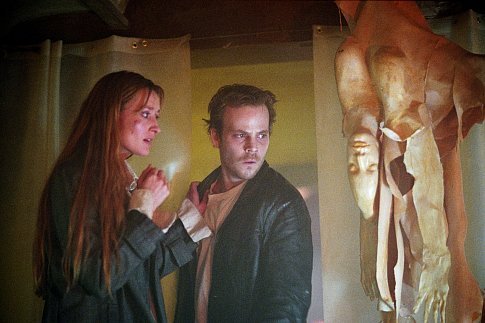
So you get scenes of stubbly Dorff and fragrant McElhone investigating (and, wait, is this a romance I see before my NOT BLEEDING eyes?) punctuated by people being killed by, fair’s fair, quite inventive and not entirely unsadistic, visualisations of their worst fears. So the forensic specialist (Amelia Curtis) investigating the hard drives (“My God, it’s written in ghost-Java script!”, she doesn’t say) imagines lots of insects because a lot of people don’t like insects, and dies. BLEEDING FROM THE EYES! Dorff’s boss (Nigel Terry) imagines being an actor who stars as King Arthur in John Boorman’s delightfully British Excalibur (1981) but twenty years later is way down the cast in this shit, and crashes his car. While BLEEDING FROM HIS EYES! And so on. Purely in the interests of research (yeah, right; that’s what they all say) porcelain skinned public servant Natasha McElhone views the spooky site and the race is on to save her from her own worst fears and BLEEDING FROM THE EYES! And what connection does all this have to do with Stephen Rea’s preposterously silly performance as a serial killer Dorff failed to catch in the past, and whose scenes all seem to have been shot in one day? Questions there, like anyone cares.

Feardotcom is a bad movie, but a bad horror movie isn’t like a normal bad movie; it can still be entertaining, which this is. There’s the fun of rolling your non-haemorrhaging orbs at the clichés, the grudging tip of the hat to the imagination on show in the deaths, the little tickle you get when you realise someone somewhere thought they were making a SERIOUS FILM! here, the historical interest of how the Internet was perceived 16 years ago, the magic of Udo Kier, John Terry and, particularly, Jeffrey Combs being way more interesting than anyone further up the cast list can manage. And Combs is such a particular delight in this as a grubby apathetic cop, Feardotcom briefly becomes a better movie whenever he slouches onscreen. It’s still very far from good though, but still better than something as slickly dishonest as Frost/Nixon. And my mum? She said it was okay (but between you and me I think she nodded off. Bless.)

#feardotcom#jeffrey combs#william malone#stephen dorff#natascha mcelhone#stephen rea#horror#movies#serial killer#2002#2000s#united kingdom#luxembourg#united states#germany#udo kier
4 notes
·
View notes
Text
Frank Worthington: A personal memory
IF Stalybridge Celtic signed Frank Worthington as a publicity stunt, it worked perfectly. Bower Fold was crammed that Boxing Day afternoon in 1988, and apparently the takings cleared the club's overdraft.
As lockdown prevents me from checking what I and others wrote at the time, I'm having to rely on my fraying memory. But the crowd for that derby against a Hyde United including John Bishop must have been at least 1,700. All four sides of the pitch were hemmed in by spectators with no gaps to be seen.
I'm sure even the Tigers fans were hoping to see Frank to weave the odd bit of magic to entertain them, so long as they didn't lose. There was a collective sense of anticipation whenever he got the ball — an intake of breath, necks craning, eyes opening that little bit wider — but Worthington largely stayed in his box. There was just the odd spark here and there.
I seem to recall a tricky free kick, but that was about it. I'm told he missed a penalty, although I've no recollection. The game ended in a 1-0 win to the Tigers, Ricky Harris scoring the goal.
To be fair to Frank, top players rarely shine at non-league level. The only one I can think of is former Manchester City and Oldham defender Kenny Clements and I still remember him one very wet Saturday, slowly hauling himself up from the National Park mud, rain pounding into his face, with a look that said: "What the hell am I doing here?"
There's always someone who wants to make a name for himself by crunching a star. Denis Law told me that's one of the reasons he never played again after announcing his retirement. He even turned down an invitation to sign for Stalybridge Celtic.
When Celtic signed Frank Worthington, it was big news. He went to Bower Fold with his former Bolton team-mate Paul Jones. Jones held Frank in the highest esteem, commenting a few years ago: "Frank Worthington would have put people like Ronaldo in the shade." Praise indeed.
After the game, in the Sportsman on Mottram Road (now an estate agent's office), Bridge secretary Martyn Torr manoeuvred me through the packed pub to get a few words with the great man.
Of course, being me, I did my best to fluff it. "How did you find Stalybridge Celtic?" I blurted.
"Well I got on the M62 and headed west," came the reply.
At the time, Frank would have been just 40, and with his lank hair and moustache he reminded me of a Wild West gunslinger. He looked more like Wild Bill Hickok than his hero Elvis. But I suppose a gunslinger is what he was. He was quick on the draw with his footballing skills rather than his Colt 45s.
My first memories of Frank were forged when Huddersfield were promoted to the first division under the management of former Manchester United midfielder Jimmy Nicholson.
The only time I saw him play before his appearance at Bower Fold was at Old Trafford on April 11, 1979. He'd found the net to cancel out Martin Buchan's goal and deep into injury time, with the score still 1-1, I left to get the bus home.
On the 330 from Hyde to Dukinfield, the conductor (remember them?) saw my United scarf and asked me the result. "A 1-1 draw," I told him, and somebody shouted from the back: "No, Bolton won 2-1." Frank had scored about six minutes into injury time. I was gutted.
What did Frank get for his efforts? I understand he was paid the princely sum of £100 in cash for his Stalybridge Celtic appearance and promptly blew the lot in the pub and in an Indian restaurant on Market Street.
I have the feeling he played one more game for the Bridge but I'm told he didn't. Whatever the truth, that Christmas afternoon at Bower Fold provided me with a special memory of a truly talented and special player.
Need to ring my son now to tell him all about the day I met the great Frank Worthington.
0 notes
Text
2017 Movie Odyssey Awards
For all my followers out there, I have two final posts left for this year’s Movie Odyssey. This is the penultimate one and the second-most important of all: the awards ceremony. Based on 230+ feature- and short-films that I saw this year for the first time in their entirety, here is an Oscar-like ceremony celebrating twenty-six categories of filmmaking completed over a hundred years. The ten best motion pictures of the year that I saw this year lead us off.
Thanks again for everyone’s support. A Happy New Year to you and your loved ones, and the full list for the 2017 Movie Odyssey will be out at around 8 PM Pacific!
Best Pictures (I'm naming ten, I'm not distinguishing one above the other nine)
A Brighter Summer Day (1991, Taiwan)
Captain Blood (1935)
Friendly Persuasion (1956)
In the Mood for Love (2000, Hong Kong)
The Lady Vanishes (1938)
Lonely Are the Brave (1962)
A Man There Was (1917, Sweden)
Sweet Smell of Success (1957)
Tokyo Twilight (1957, Japan)
A Touch of Zen (1971, Taiwan)
In the Mood for Love, The Lady Vanishes, Sweet Smell of Success, Tokyo Twilight, and A Touch of Zen received 10/10 ratings. All others received 9.5/10.
Best Comedy
Blackbeard’s Ghost (1968)
Destry Rides Again (1939)
Dr. Jack (1922)
The Great Muppet Caper (1981)
Kung Fu Hustle (2004, Hong Kong/China)
Mr. & Mrs. ’55 (1955, India)
Much Ado About Nothing (1993)
Porco Rosso (1992, Japan)
The Sandlot (1993)
Yoyo (1965, France)
Hey, I’m just looking for the movie that made me laugh the most here.
Best Musical
Coco (2017)
Funny Face (1957)
The Great Muppet Caper
It’s Always Fair Weather (1955)
Kid Galahad (1962)
Mr. & Mrs. ‘55
Nashville (1975)
Pink Floyd – The Wall (1982)
Take Me Out to the Ball Game (1949)
You Were Never Lovelier (1942)
It’s not a fully original musical, but it contains some of the best arrangement of George and Ira Gershwin music you could find. You Were Never Lovelier and Mr. & Mrs. ‘55 and It’s Always Fair Weather also threatened here.
Best Animated Feature
The Breadwinner (2017)
Castle in the Sky (1986, Japan)
Fantastic Planet (1973, France/Czechoslovakia)
My Life as a Zucchini (2016, Switzerland)
My Neighbor Totoro (1988, Japan)
Ponyo (2008, Japan)
Porco Rosso
The Red Turtle (2016, France/Belgium/Japan)
Your Name (2016, Japan)
A much stronger year for animation this year than the previous Movie Odyssey. Fantastic competition, with what I think is a great winner.
Best Documentary
Don’t Look Back (1967)
The Horse with the Flying Tale (1960)
Jungle Cat (1959)
Life, Animated (2016)
Monterey Pop (1968)
The Statue of Liberty (1985)
Swim Team (2016)
The Tattooed Police Horse (1964)
Tyrus (2015)
Best Non-English Language Film
Aguirre, the Wrath of God (1972), West Germany
A Brighter Summer Day, Taiwan
Charulata (1964), India
In the Mood for Love, Hong Kong
My Life as a Zucchini, Switzerland
My Neighbor Totoro, Japan
The Salesman (2016), Iran
Sound of the Mountain (1954), Japan
Tokyo Twilight, Japan
A Touch of Zen, Taiwan
Best Silent Film
Camille (1921)
Dr. Jack
Ducks and Drakes (1921)
The Last of the Mohicans (1920)
A Man There Was
Now or Never (1921 short)
Sparrows (1926)
Strike (1925, Soviet Union)
Tokyo Chorus (1931, Japan)
West of Zanzibar (1928)
Personal Favorite Film
Akeelah and the Bee (2006)
Coco
Destry Rides Again
The Goonies (1985)
The Great Muppet Caper
Lady Bird (2017)
The Lady Vanishes
Lonely Are the Brave
My Life as a Zucchini
Pollyanna (1960)
It might be one of the best neo-Westerns I have ever seen. Kirk Douglas said it was his personal favorite movie, and it’s obvious and you can see why.
Best Director
Michael Curtiz, Captain Blood
Stanley Donen, Funny Face
Alfred Hitchcock, The Lady Vanishes
King Hu, A Touch of Zen
Rex Ingram, The Four Horsemen of the Apocalypse
Alexander Mackendrick, Sweet Smell of Success
Jean Renoir, The Southerner (1945)
Victor Sjöström, A Man There Was
Wong Kar-wai, In the Mood for Love
Edward Yang, A Brighter Summer Day
Holy hell this is a strong field. I desperately wanted to find an excuse to put in Greta Gerwig as Best Director for Lady Bird, but I never found it. Congrats to Hitchcock, for may be the best-directed work I’ve seen from him.
Best Acting Ensemble
A Brighter Summer Day
Caged (1950)
Fences (2016)
Friendly Persuasion
Pollyanna
Road to Perdition (2002)
Sense and Sensibility (1995)
Sound of the Mountain
Sweet Smell of Success
Tokyo Twilight
Now, none of the actors from Fences are going to win an individual award as you seen down below. But together, they were outstanding and surpassed all comers this year.
Best Actor
Gary Cooper, Friendly Persuasion
Tony Curtis, Sweet Smell of Success
Kirk Douglas, Lonely Are the Brave
Charles Laughton, Island of Lost Souls (1932)
Gregory Peck, Twelve O’Clock High (1949)
Edward G. Robinson, Scarlet Street (1945)
Andy Serkis, War for the Planet of the Apes (2017)
Victor Sjöström, A Man There Was
Denzel Washington, Fences
Robin Williams, What Dreams May Come (1998)
I’ve already commented how brilliant Douglas is here. Also in prime contention were Robinson, Serkis, and, yes, Robin Williams.
Best Actress
Ineko Arima, Tokyo Twilight
Leslie Caron, Lili (1953)
Maggie Cheung, In the Mood for Love
Viola Davis, Fences
Olivia de Havilland, Captain Blood
Chôko Iida, Record of a Tenement Gentleman (1947, Japan)
Dorothy McGuire, Friendly Persuasion
Madhabi Mukherjee, Charulata
Eleanor Parker, Caged
Mary Pickford, Sparrows
As a lonely wife, Mukherjee does so much with so little dialogue. You almost wonder if she could have excelled in silent film, too. Cheung, de Havilland, and Iida were also considered the strongest contenders here.
Best Supporting Actor
Dan Duryea, Scarlet Street
Henry Gibson, Nashville
Stephen Henderson, Fences
Burt Lancaster, Sweet Smell of Success
Paul Newman, Road to Perdition
Anthony Perkins, Friendly Persuasion
Alan Rickman, Sense and Sensibility
Patrick Stewart, Logan (2017)
Gustav von Seyffertitz, Sparrows
Mykelti Williamson, Fences
Supporting categories love a villain. And as the immoral columnist J.J. Hunsecker, Burt Lancaster commands Sweet Smell of Success whenever he is on screen. A terrific performance.
Best Supporting Actress
Ronee Blakley, Nashville
Hope Emerson, Caged
Elsa Lanchester, The Big Clock (1948)
Charlotte Mineau, Sparrows
Agnes Moorehead, Caged
Kay Thompson, Funny Face
Lily Tomlin, Nashville
Michelle Williams, Manchester by the Sea (2016)
May Whitty, The Lady Vanishes
Kate Winslet, Sense and Sensibility
I’m usually not kind to comedic performances, but I have to give it to Kay Thompson here. She was ebullient and heavens-to-goodness hilarious in Funny Face. A great singing voice, too.
Best Adapted Screenplay
James Bernard, Roy Boulting, Paul Dehn, and Frank Harvey, Seven Days to Noon (1950)
Kenneth Branagh, Much Ado About Nothing
Sidney Gilliat and Frank Launder, The Lady Vanishes
Yasunari Kawabata and Yôko Mizuki, Sound of the Mountain
Al Morgan and José Ferrer, The Great Man (1956)
Clifford Odets and Ernest Lehman, Sweet Smell of Success
Satyajit Ray, Charulata
Bernard C. Schoenfeld and Virginia Kellogg, Caged
Céline Sciamma, Claude Barras, Germano Zullo, and Morgan Navarro, My Life as a Zucchini
Michael Wilson, Friendly Persuasion
Best Original Screenplay
Sean Baker and Chris Bergoch, The Florida Project (2017)
Guillermo del Toro and Vanessa Taylor, The Shape of Water (2017)
Asghar Farhadi, The Salesman
Greta Gerwig, Lady Bird
Tadao Ikeda and Yasujirô Ozu, Record of a Tenement Gentleman
Frances Marion, Joe Farnham, and Martin Flavin, The Big House (1930)
Yasujirô Ozu and Kôgo Noda, Tokyo Twilight
William A. Wellman, Robert Carson, Dorothy Parker, and Alan Campbell, A Star Is Born (1937)
Wong Kar-wai, In the Mood for Love
Edward Yang, Hung Hung, Alex Yang, and Mingtang Lai, A Brighter Summer Day
Best Cinematography
Hoyte van Hoytema, Dunkirk (2017)
William H. Daniels, The Far Country (1954)
John F. Seitz, The Four Horsemen of the Apocalypse
Ray June, Funny Face
Christopher Doyle and Mark Lee Ping Bin, In the Mood for Love
Karl Struss, Island of Lost Souls
Julius Jaenzon, A Man There Was
Conrad Hall, Road to Perdition
James Wong Howe, Sweet Smell of Success
Hua Hui-ying, A Touch of Zen
Best Film Editing
Lee Smith, Dunkirk
Frank Bracht, Funny Face
Norman R. Palmer, The Incredible Journey (1963)
William Chang, In the Mood for Love
R.E. Dearing, The Lady Vanishes
Gene Havlick and Gene Milford, Lost Horizon (1937)
Ray Boulting and John Boulting, Seven Days to Noon
King Hu and Wing Chin-chen, A Touch of Zen
Tom Held, San Francisco (1936)
Henri Lanoë, Yoyo
Best Adaptation or Musical Score
Richard Baskin, Nashville
Adolph Deutsch, Funny Face
Adolph Deutsch, Take Me Out to the Ball Game
Bob Dylan, Pat Garrett and Billy the Kid (1973)
Leigh Harline, You Were Never Lovelier
O.P. Nayyar, Mr. & Mrs. ‘55
Alfred Newman and Lionel Newman, There’s No Business Like Show Business
André Previn, It’s Always Fair Weather
Joe Raposo, The Great Muppet Caper
Richard M. Sherman, Robert B. Sherman, and Buddy Baker, Summer Magic (1963)
This comes to the strength of the entire adaptation or musical score, not just the best songs. As a whole, I felt like It’s Always Fair Weather had the most going for it compared to the other seen here. I didn’t care for Baskin’s or Dylan’s work outside of a single song from each. Funny Face, Mr. & Mrs. ‘55, and There’s No Business Like Show Business were next in line.
Best Original Score
David Arnold, Independence Day (1996)
Elmer Bernstein, Sweet Smell of Success
Alexandre Desplat, Valerian and the City of a Thousand Planets (2017)
Patrick Doyle, Sense and Sensibility
Jerry Goldsmith, MacArthur (1977)
Joe Hisaishi, Castle in the Sky
Erich Wolfgang Korngold, Captain Blood
Thomas Newman, Road to Perdition
Dimitri Tiomkin, Friendly Persuasion
John Williams, Star Wars: The Last Jedi (2017)
Tiomkin has never won yet, but now one of my favorite movie composers has finally triumphed in this category with a gorgeous, lush score that swats away close competition from Independence Day, Castle in the Sky, and Captain Blood.
Best Original Song
“Blue Gardenia”, music and lyrics by Bob Russell and Lester Lee, arranged by Nelson Riddle, The Blue Gardenia (1953)
“Bonjour, Paris!”, music and lyrics by Roger Edens and Leonard Gershe, Funny Face
“I Like Myself”, music by André Previn, lyrics by Betty Comden and Adolph Green, It’s Always Fair Weather
“I’m Easy”, music and lyrics by Keith Carradine, Nashville
“Knockin’ on Heaven’s Door”, music and lyrics by Bob Dylan, Pat Garrett and Billy the Kid
“My Neighbor Totoro”, music by Joe Hisaishi, lyrics by Hayao Miyazaki, My Neighbor Totoro
“No Wrong Way Home”, music by Alexis Harte and J.J. Weisler, lyrics by Alexis Harte, Pearl (2016 short film)
“Remember Me (Recuérdame)”, music and lyrics by Robert Lopez and Kristen Anderson-Lopez, Coco
“San Francisco (Be Sure to Wear Flowers in Your Hair)”, music and lyrics by John Phillips, Monterey Pop
“Zenzenzense”, music and lyrics by Yôjirô Noda, Your Name
Thanks again to all those who participated!
Best Costume Design
Milo Anderson, Captain Blood
Edith Head and Hubert de Givenchy, Funny Face
Dorothy Jeakins, My Cousin Rachel (1952)
Walter Plunkett, Pollyanna
Adrian, San Francisco
Jenny Beavan and John Bright, Sense and Sensibility
Leo Bei, Gerdago, and Franz Szivats, Sissi (1955, Austria)
Leo Bei, Gerdago, and Franz Szivats, Sissi: The Young Empress (1956, Austria)
Charles LeMaire, Travilla, and Miles White, There’s No Business Like Show Business
Li Chia-Chih, A Touch of Zen
Best Makeup and Hairstyling
Roy Ashton and Frieda Steiger, Brides of Dracula (1960)
Tom Savini, Taso N. Stavrakis, Katharine Vickers, and Cecilia Verardi, Friday the 13th (1980)
Charles Gemora and Wally Westmore, Island of Lost Souls
Sarah Craig and Stephanie Ingram, It (2017)
Uncredited, Jigoku (1960, Japan)
Jordan Samuel and Paula Fleet, The Shape of Water
Fritz Jelinek, Jupp Paschke, and Heinz Stamm, Sissi
Uncredited, The Southerner
Uncredited, Sparrows
Thi Thanh Tu Nguyen and Félix Puget, Valerian and the City of a Thousand Planets
Best Production Design
Anton Grot, Captain Blood
Joseph Calder and Amos Myers, The Four Horsemen of the Apocalypse
J. Michael Riva and Rick Carter, The Goonies
Stephen Goosson and Babs Johnstone, Lost Horizon
Carroll Clark, Robert Clatworthy, Emile Kuri, and Fred M. MacLean, Pollyanna
Cedric Gibbons, San Francisco
Fritz Jüptner-Jonstorff, Sissi: Fateful Years of an Empress (1957, Austria)
Fritz Jüptner-Jonstorff, Sissi: The Young Empress
Chen Shang-Lin, A Touch of Zen
Eugenio Zanetti and Cindy Carr, What Dreams May Come
Achievement in Visual Effects (all films nominated here are winners because it’s unfair to have a 1930s film with groundbreaking visual effects compete with a 2010s film)
Captain Blood
Dawn of the Planet of the Apes
Dunkirk
Independence Day
Kong: Skull Island (2017)
Lost Horizon
San Francisco
Star Wars: The Last Jedi
Tom Thumb (1958)
Tremors (1990)
Valerian and the City of a Thousand Planets
War for the Planet of the Apes
What Dreams May Come
Worst Picture
Ben (1972)
Beyond the Poseidon Adventure (1979)
Dr. Goldfoot and the Bikini Machine (1965)
Friday the 13th
The Happening (2008)
Independence Day: Resurgence (2016)
Olaf’s Frozen Adventure (2017 short)
Return of the Fly (1959)
Willard (1971)
The X from Outer Space (1967, Japan)
OH GOD WHY
HONORARY AWARDS
Five Came Back (TV series), for illustrating the history of WWII experiences through the prism of Hollywood
Loving Vincent (2017), for giving new meaning to the phrase “every frame a painting” – an international artistic triumph
National Film Board of Canada (NFB), for decades of delights and invention in its animated short films
June Foray (posthumously), for a long, accomplished career that made her one of the greatest voice actresses in film history
Pearl, for innovative use of virtual reality in animated filmmaking
Robert Osborne (posthumously), for many years of introducing classic movies on TCM – a calming, erudite presence to his fans and a hero to this blogger
Jack Shaheen (posthumously), for his tireless research spotlighting and critiquing portrayals of Arabs and Muslims in cinema
Tyrus Wong (posthumously), for his impactful artistry long overlooked – one of the greatest artists that ever worked in Hollywood
FILMS WITH MULTIPLE NOMINATIONS (61... excluding Worst Picture)
Eight: Funny Face; Sweet Smell of Success
Seven: Captain Blood; Friendly Persuasion; In the Mood for Love
Six: The Lady Vanishes; Nashville
Five: A Brighter Summer Day; Fences; A Man There Was; Sense and Sensibility; Sparrows; Tokyo Twilight; A Touch of Zen
Four: Caged; The Four Horsemen of the Apocalypse; The Great Muppet Caper; Lonely Are the Brave; My Life as a Zucchini; Pollyanna; Road to Perdition; San Francisco
Three: Charulata; Coco; Dunkirk; Independence Day; Island of Lost Souls; It’s Always Fair Weather; Lost Horizon; Mr. & Mrs. ‘55; My Life as a Zucchini; My Neighbor Totoro; Sound of the Mountain; There’s No Business Like Show Business; Valerian and the City of a Thousand Planets; What Dreams May Come
Two: Aguirre, the Wrath of God; The Big House; Castle in the Sky; Destry Rides Again; Dr. Jack; The Goonies; Lady Bird; Monterey Pop; Much Ado About Nothing; Pat Garrett and Billy the Kid; Porco Rosso; Record of a Tenement Gentleman; The Salesman; Scarlet Street; Seven Days to Noon; The Shape of Water; Sissi; Sissi: The Young Empress; Sound of the Mountain; The Southerner; Star Wars: The Last Jedi; Take Me Out to the Ball Game; War for the Planet of the Apes; You Were Never Lovelier; Your Name; Yoyo
WINNERS (excluding honorary awards and Worst Picture... 31)
3 wins: In the Mood for Love; Lonely Are the Brave; Sweet Smell of Success
2 wins: Captain Blood; Dunkirk; Friendly Persuasion; Funny Face; The Lady Vanishes; A Man There Was; Valerian and the City of a Thousand Planets; What Dreams May Come
1 win: Blackbeard’s Ghost; A Brighter Summer Day; Charulata; Coco; Dawn of the Planet of the Apes; Fences; Independence Day; It’s Always Fair Weather; Kong: Skull Island; Lost Horizon; Monterey Pop; The Red Turtle; Road to Perdition; San Francisco; Sissi; Star Wars: The Last Jedi; Tokyo Twilight; Tom Thumb; Tremors; War for the Planet of the Apes
111 films were nominated in 26 categories.
9 notes
·
View notes
Text
Orange County Community Hosts Online ANCA Town Hall on Artsakh Security
New Post has been published on https://armenia.in-the.news/society/orange-county-community-hosts-online-anca-town-hall-on-artsakh-security-22060-19-06-2020/
Orange County Community Hosts Online ANCA Town Hall on Artsakh Security

ARF Orange County ‘Armen Karo’ Chapter Chair Garo Kiledjian discussing Artsakh security and the flawed Madrid Principles with ANCA Executive Director Aram Hamparian in a Facebook Live Presentation hosted by the Orange County, California community organizations.
SANTA ANA, Calif.—A wide array of Orange County community organizations joined forces recently with the Armenian National Committee of America in hosting an online question and answer session on the ongoing Artsakh peace negotiations, the reckless Madrid Principles, and the path forward to a truly durable, democratic resolution of Artsakh-Azerbaijan status and security issues.
The June 2nd Facebook Live event, moderated by ARF Orange County ‘Armen Karo’ Chapter Chair Garo Kiledjian, featured a presentation by ANCA Executive Director Aram Hamparian.
“The Orange County community appreciated the opportunity to have an in-depth discussion with the ANCA about the flawed Madrid Principles which put Artsakh security and freedom in jeopardy,” explained Kiledjian. “They should be rejected immediately and replaced with a balanced plan based upon the right to self-determination of the people of Artsakh.” Kiledjian continued, noting “it is particularly disturbing to hear of the U.S. State Department’s efforts to de-fund life-saving Artsakh demining projects, particularly when military assistance to Artsakh has increased to over $100 million. Such decisions only serve to put U.S. impartiality as a mediator in question as we continue to seek a long-term, sustainable Artsakh solution.”
Kiledjian opened the online forum asking Hamparian to review the ANCA’s policies, priorities, and results on a broad range of issues from justice for the Armenian Genocide, to US-Armenian ties, US foreign assistance, US-Turkey ties, and the ANCA’s commitment to youth empowerment. Hamparian noted that the ANCA’s positions in each of these areas are part of a 360-degree advocacy strategy, with a single aim: the security, prosperity, and long-term viability of a free, independent, and united Armenian homeland.
The discussion then focused on the central theme of the evening, US policy on Artsakh, during which time Hamparian and Kiledjian took a deep dive into U.S. aid to Artsakh and the ongoing peace negotiations, including the unjust Madrid principles, highlights of which are provided below.
The Madrid Principles: Unfair, Fake, and Unenforceable
Hamparian offered an overview of the Organization for Security and Cooperation in Europe (OSCE) Minsk Group supported “Madrid Principles,” first referenced by the Artsakh peace mediators some 13 years ago. The flawed proposal calls for a phased Artsakh settlement in which the Armenian side would cede six or more territories liberated during the 1988-1994 war with Azerbaijan in return for an “expression of will,” to be held at an undetermined time in the future, which purportedly would ensure security and determine its long-term status.
The deal is “land now, status later; you might say, land now, for peace later; or land now, for status later; or land now, for a piece of paper that talks about status and peace later,” explained Hamparian. “Those terms are so ridiculously unfair that I don’t think there is more that needs to be said. Would anyone of the [OSCE] mediators – the Russians, the French, the Americans – take a deal like that for their own house? Would they accept a deal where they sign over the title to their home in return for an agreement to talk about compensation down the road.”
Hamparian described the Madrid Principles as a “fake deal”, noting that even-before being negotiated and agreed upon, Azerbaijani government officials are walking away from the agreement, arguing that upon Armenian ‘return’ of lands, the people of Artsakh should rely on Azerbaijani government security guarantees extended to Artsakh’s Armenian and Azerbaijani communities.
“So you give up all your land, you give up all your security, you put at risk the rest of Armenia, and in return, you get a deal worse than what we had under the Soviets. A deal worse than before Azerbaijan lost a war against Artsakh,” explained Hamparian. “Having established an independent Artsakh, having built a free and open society, having held free and fair elections for more than a generation, why would we cede all of that in order to go back to where we were under the Soviets, in the process trusting Azerbaijan that Aliyev won’t take advantage of the process and just press for more concessions?”
Hamparian also argued that the Madrid Principles are totally unenforceable, noting “all the concessions the Armenian side is expected to make are made on day one. After that first stage, Azerbaijan will control this historic Armenian homeland, will control the strategic territories and heights, and the Armenian side will be left with a piece of paper. What is that piece of paper worth? If Azerbaijan responds in good faith to an Armenian good faith surrender of territory, then possibly down the road, you could have peace. But does anyone believe, for even a second, that Azerbaijan responds in good faith? Isn’t it much more likely, in fact certain, that Azerbaijan would leverage those concessions to then take the next steps against Zangezur, and the rest of Armenia? It’s hard to believe that Armenian concessions lead to a less aggressive Azerbaijan.”
Hamparian continued that the other part of the deal’s unenforceability is the international community’s response to future Azerbaijani aggression. “Let’s say Azerbaijan doesn’t honor its commitments, and the Armenians find themselves under attack. Does anyone think that international peacekeepers from wherever – do we think those countries will send their young men and women to fight and die to protect the citizens of Artsakh? You might, but I wouldn’t bet my life on it.”
The ANCA has set up a community action alert – anca.org/rejectmadrid – sharing concerns about the reckless Madrid Principles with Members of Congress.
On U.S. State Department Efforts to End Artsakh Demining Assistance to “Prepare Populations for Peace”
Kiledjian asked the ANCA’s Hamparian for an update on recent U.S. Embassy to Armenia announcements that the life-saving U.S. funding for Artsakh demining would be replaced by programs to “prepare populations for peace” as part of ongoing efforts for an Artsakh settlement.
“If preparing populations for peace requires killing a humanitarian demining program, that’s very bad preparation,” said Hamparian. “In fact, that’s the opposite of preparing populations for peace. Every landmine accident – in Artsakh, Azerbaijan, or Armenia – are tragedies, with the victims often farmers, and many times children. So the concept that our government – the U.S. government – believes that preparing populations for peace means leaving landmines in the ground that will kill people – is just terrible.”
Hamparian went on to state, “ You can’t throw out a clever phrase like ‘preparing populations for peace,’ and expect us not to scrutinize it. On the surface, who could conceivably be against that? Well, if it’s just a matter of arm-twisting Yerevan, pressuring Stepanakert, with no similar pressure on the Azerbaijani side – then we reject that. That’s just a game.”
The ANCA is working with Appropriations Committee members in the U.S. Senate and House to ensure continued funds for Artsakh de-mining and rehabilitation services like those provided by the Lady Cox Rehabilitation Center are included in the Fiscal Year 2021 foreign aid bill. A nationwide call to action is available at anca.org/aid.
Artsakh Must Be an Equal Party in the Peace Process
“It is a generally accepted principle of international law that agreements shouldn’t be made about parties; agreements should be made with parties,” explained Hamparian, when asked about the absence of the Republic of Artsakh at the OSCE-mediated peace talks. “Azerbaijan is obviously against this because they feel it will prejudice the outcome. They didn’t feel that way in 1994, when they were losing on the battlefield. They were eager to sign an agreement with Armenia and Artsakh that established a cease-fire. […] Now, that the ceasefire is in effect, they want to push Artsakh as far away as possible. That’s wrong on moral grounds, because you can’t make decisions for people. It’s wrong on legal grounds because it’s against every principle of international law to sign accord about people, without the participation of the party in question. It’s also not sustainable. If Azerbaijan is in fact interested in a sustainable solution to Artsakh, it needs to sit at the table with the leaders of Artsakh. That’s ultimately where this issue gets resolved,” concluded Hamparian.
The ANCA is leading efforts to secure passage of Congressman Frank Pallone (D-NJ) Artsakh Travel and Communication Act (H.Res.190), which calls for more open U.S.-Artsakh dialogue and for the Republic of Artsakh to join Armenia and Azerbaijan as an equal partner in the negotiating process. To encourage Congressional support for the initiative, visit anca.org/USArtsakh.
The Facebook Live event was sponsored by the Orange County ARF Armen Karo Chapter, ANCA Orange County Chapter, Forty Martyrs Armenian Apostolic Church, Ari Guiragos Minassian Armenian School, AYF Ashod Yergat Chapter, AYF Aghpiur Serop Juniors, ARS Sevan Chapter, ARS Karni Chapter, Homenetmen Sartarabad Chapter, and Hamazkayin Siamanto Chapter. The organizers thanked the ANCA for their continuous efforts in advocacy, community education, and for a successful informational event.
Read original article here.
0 notes
Text
Here’s Where Ontario’s Next Crop of Legal Cannabis Stores Will Open
The Alcohol and Gaming Commission of Ontario (AGCO) has announced the results of its latest cannabis retail store lottery which attracted 4,864 applications.
Held on August 20, 2019, winners of the lottery will be alotted one of the 42 new store authorizations after meeting pre-qualification requirements. The lottery was overseen by a third-party fairness monitor and winners were notified following the draw.
Selected applicants now have until August 28, 2019 to apply for a cannabis Retail Operator Licence and a Retail Store Authorization at which point “the AGCO will undertake its full eligibility and licensing review,” according to this morning’s announcement.
If successful, the new stores will open in the following jurisdictions across Ontario and will join the first 25 cannabis stores which were authorized to open in Ontario in April of 2019.
Selected Applicants and Proposed Locations
East Region
Barrie
Sofia Kuliev, 65 Collier St., Collingwood
Louis Laskovski, 312 Hurontario St.
Innisfil
Ronen Ackerman, 2008 Commerce Park Dr.
German Olga, 1988 Commerce Park Dr.
Illim Uzunova, 1982 Commerce Park Dr.
Kawartha Lakes
Huge Shops Ontario Inc., 566 Frank Hill Rd.
Ottawa
Ethan Stark, 4335 Strandherd Dr., Unit 3,4,5
North Region
Kenora
Carl Ignatius, 420 Second St. S.
North Bay
Lorne J. Fine, 390 Lakeshore Dr. Suite 3
Sault Ste. Marie
Thomas Miszuk, 317 Northern Ave. E.
Timmins
CC Alliance, 273 Pine Street S.
Thunder Bay
Gerald Harrison, 1802 Victoria Ave. E.
GTA Region
Aurora
Grant Willson, 15243 Yonge St., Unit 3
Burlington
2674620 Ontario Limited, 1505 Guelph Line Unit 3-4
Cory Floyd Cacciavillani, 1025 Plains Rd. E.
Oshawa
Ekrem Uzunova, 20 Simcoe St. S.
Ravino Junaev, 20 Simcoe St. S.
Stouffville
Corner Grass Corp., 5779 Main St. Unit 105
Toronto Region
North
2464 Dufferin Inc., 2464 Dufferin St.
Central
9247220 Canada Ltd., 570 Bloor St. W.
11180673 Canada Inc., 104 Harbord St.
2708654 Ontario Ltd., 501 Church St., Unit 4B
Maria Laura Rasile, 237 Queen St. W.
Junaid Khan, 815 Queen St. W.
2197130 Alberta Ltd, 1180 Queen St. W.
East
Helene Vassos, 730 Danforth Ave. Suite 1
Varant Kichian, 213 Queen St. E.
Brian F Parker, 1303 Queen St. E.
Jason Krulicki, 2480-2490 Gerrard St. E. Unit 20A
Najla Guthrie, 964 Kingston Rd.
West Region
Ancaster
Eleonora Plata, 1142 Wilson St. W., Unit 9
Guelph
John Reynolds, 120 Wyndham St. N
Hamilton
2249364 Ontario Inc., 1400 Upper James St. Suite
Kitchener
Patricia, Gertrude, Donnelly, 589 FAIRWAY RD S
London
Robert Chomiak, 1310 Fanshawe Park Rd. W. Unit F1
Noah Soberano, 1135 Richmond St.
Niagara Falls
Bara Bahlul, 8685 Lundy’s Lane Unit 6
St. Catharines
Hratch Abrahamian, 395 Ontario St. Suite B2
Stoney Creek
11535447 Canada Corp., 1338 S. Service Rd., Building C 5 Unit 2
Welland
Pietro Greco, 115 Division St.
Windsor
Kyriakos G Anastasiadis, 545 Ouellette Ave.
First Nations
Chapleau Cree First Nation
Cree-Tech Inc.
Couchiching First Nation
The Wasaw Store
Mississauga First Nation
Paul Berney
Nipissing First Nation
Zachary Lacelle
Serpent River First Nation
Serpent River Economic Development Corporation
Wahgoshig First Nation
2708997 Ontario Inc.
Wikwemikong Unceded Indian Reserve #26
Wikwemikong Development Commission
CanadaGovernment of OntarioIndustryOntarioretailretail stores

Leafly Canada Staff
Leafly Canada is based in Toronto, with correspondents and contributors stretching from Newfoundland to BC. To reach our editorial staff please contact us at [email protected].
The post Here’s Where Ontario’s Next Crop of Legal Cannabis Stores Will Open appeared first on Savvy Herb Mobile Cannabis Platform.
from WordPress https://ift.tt/2Hkix6x
via IFTTT
0 notes
Text
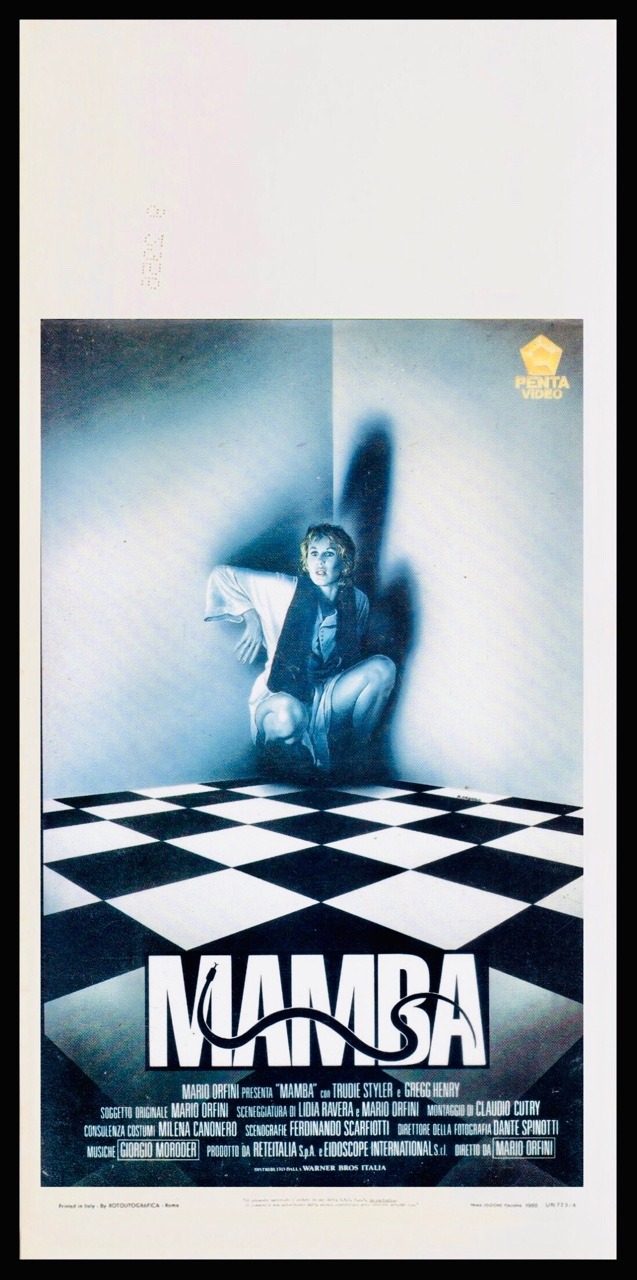
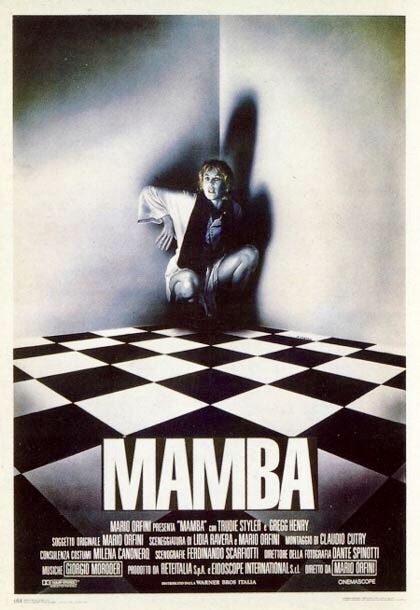
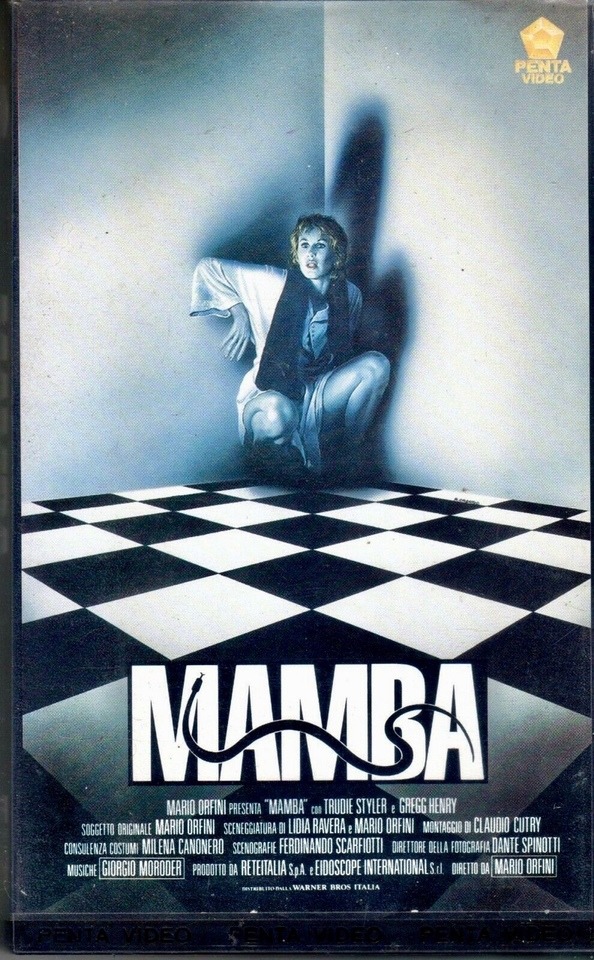

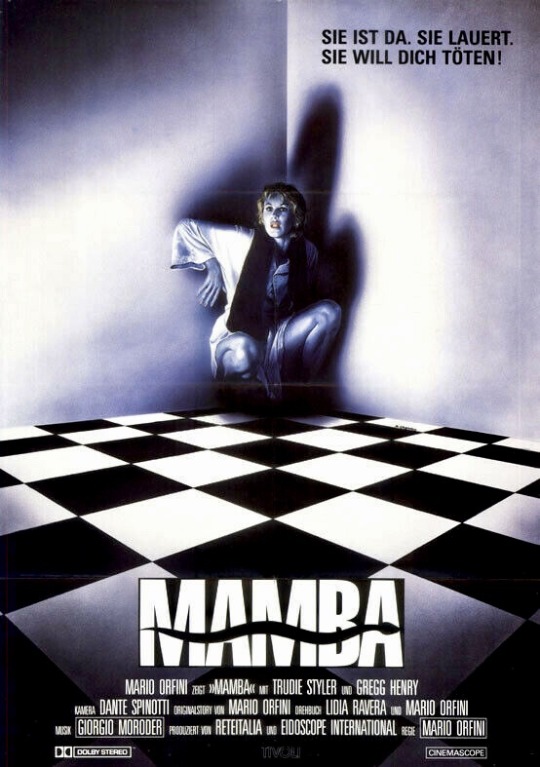


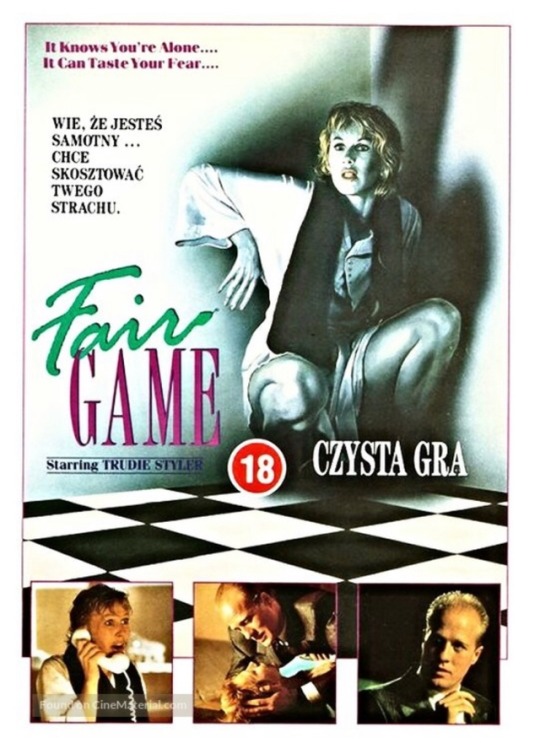
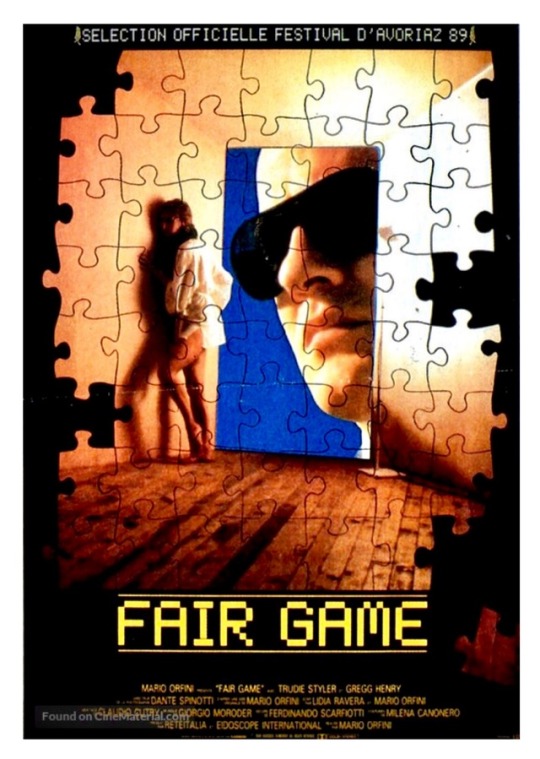
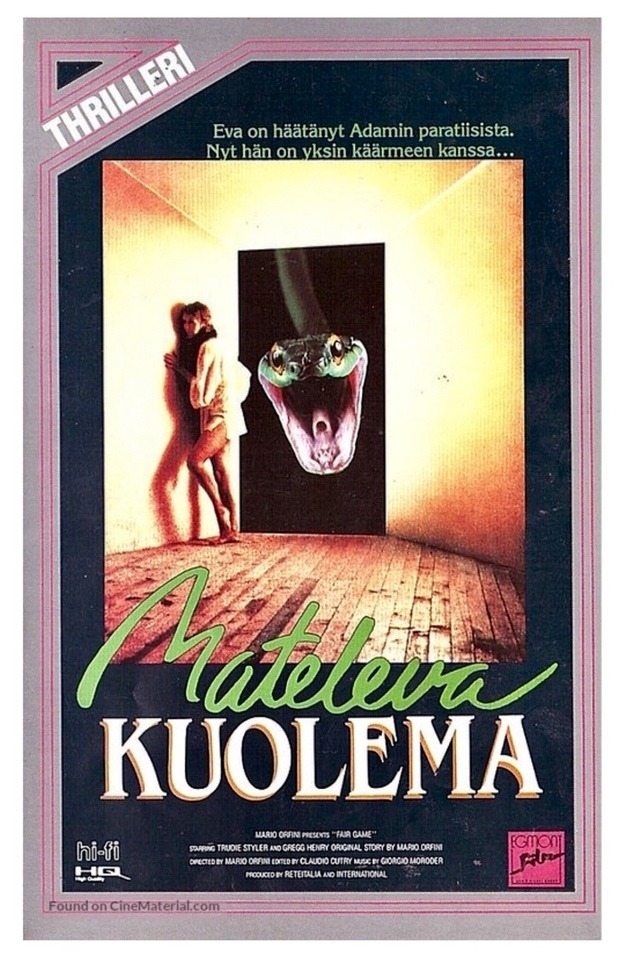
1988
Mamba (1988 film) aka Fair Game (1988 film)
Data di uscita: 1988 in Cinema 28 aprile 1989
Regista: Mario Orfini
Musiche Giorgio Moroder
Fotografia di scena Helmut Newton
Sceneggiatura: Mario Orfini, Lidia Ravera
Candidature: David di Donatello per il miglior scenografo
ART POSTER DEL MAESTRO Renato Casaro
Interpreti e personaggi
Trudie Styler: Eva
Gregg Henry: Gene
Bill Moseley: Frank
Curiosità
L'intero cast del film è composto da sole cinque persone: i due protagonisti, il procacciatore di serpenti, un passante e l'annunciatore televisivo.
Inizialmente le musiche dovevano esser composte da Peter Gabriel ma successivamente venne scelto Giorgio Moroder
Produzione
Il budget del film si aggirava attorno ai 4,6 milioni di dollari.
La lavorazione durò dieci settimane e gli interni vennero girati tutti negli studi di Cinecittà nel Teatro Tre,mentre altre scene vennero girate a Los Angeles e nel deserto del Mojave.
Durante la produzione il film cambiò varie volte il nome, da Mamba a No exit, ed infine Fair Game, il titolo statunitense.
Orfini decise di utilizzare dei mamba veri, e la produzione ne fece arrivare cinque dall'Africa equatoriale; i serpenti vennero sistemati in una gabbia di vetro riscaldata a 40 gradi.
Ogni venti giorni i mamba venivano nutriti con dei topolini bianchi.
Ai mamba vennero estratte delle ghiandole velenifere, ma questo si rivelò dannoso nei confronti dei serpenti stessi.
A causa di ciò vennero usati dei giovani pitoni ai quali veniva applicato del cerone per renderli più somiglianti ai mamba.
In tutto i serpenti erano tre, uno nero, uno grigio e uno beige.
Una delle difficoltà fu anche che i serpenti avvertivano la paura della Styler, e questi si bloccavano.
Inoltre si cercava di non stressare eccessivamente i pitoni, per cui le riprese venivano interrotte spesso. Durante le riprese due degli esemplari morirono a causa della fatica.
Per riprodurre i movimenti del mamba, Orfini usò la tecnica della steadicam.
Nella sua autobiografia, Luciano De Crescenzo ha narrato un aneddoto particolare del film: nella sceneggiatura originale era previsto che il Mamba avrebbe mangiato realmente un coniglio, ma alcuni membri della troupe non vollero che questa scena si girasse e chiamarono l'Ente Nazionale Protezione Animali. Il regista, tuttavia, approfittando della lontananza di costoro (che, nel frattempo, si erano recati al bar) girò lo stesso la scena che però ebbe un risvolto imprevisto: grazie ai suoi rapidi movimenti, fu il coniglio ad uccidere il serpente.
Gli animalisti del set brindarono all'evento ma lo scrittore napoletano li criticò: pur essendo anche lui contrario a quel crudo assassinio, non approvava il fatto che gli animali fossero divisi in "simpatici" e "antipatici"
Botteghino
Il film non fu un successo in Italia, anche perché fu realizzato specificatamente per il pubblico americano. Mamba venne distribuito nel circuito cinematografico italiano nei primi giorni del maggio 1989 e incassò 539.521.000 lire.
Gli incassi del primo giorno provenienti da Roma e Milano vennero devoluti all'Amazzonia.
Il film durante la prima messa in onda su Italia1 ottenne dei buoni risultati con 3 milioni di ascolti.
Il film ebbe maggior successo all'estero, infatti la società Overseas vendette il film a 36 paesi, tra cui 27 copie furono vendute da Orfini.
#mamba#mamba 1988#fair game#trudie styler#mario orfini#giorgio moroder#gregg henry#bill moseley#film horror#horror movies#gothic horror#italian horror#horror film#80s horror#giallo fever#giallofever#italian cult#cult#italian giallo#cinema cult#italian sexy comedy#gialli#international cult#giallo
1 note
·
View note
Text
America's love affair with firearms bleeds into gaming culture
Gaming culture is rife with graphic representations of gun violence and has been since arcade goers first blew aliens out of Space Invader's skies. You'll be hard-pressed to find more than a handful of AAA titles designed for adults (sit down Rayman) that don't rely on firearms, or use gore in substitution, either as a primary tool for the gameplay or as a thematic element.
While firearms have been a mainstay in video games since the mid '70s, few games have cemented their position in popular culture than 1993's pioneering first person shooter, Doom. Not only did Doom bring the FPS genre into mainstream gaming culture, they also helped to normalize a level of gore not often seen since 1988's Turbografx 16 hit, Splatterhouse, one of the first games to ever carry a parental warning label.
Doom's influence is clear in nearly every game in the genre. Granted, you're not going to find many Cacodemons in other franchises, but the standard weapon array -- ie pistol, shotgun, assault rifle, and rocket launcher -- has bled over to countless FPS and open-world adventure titles, from FarCry and Crysis to Uncharted and Grand Theft Auto, give or take a sniper rifle or two.
Doom may have set the stage for gunplay in gaming, but plenty of other titles have managed to tell their stories without having players shoot their way through every level. However, many of these games instead opted for ultraviolence as a stand-in for firearms. Take God of War for example, either the original series or this year's award-winning reboot. Guns don't make much sense in a story set in ancient Greece and the realm of the Norse Gods so, instead, players are treated to the opportunity to rip the jaws off of Minotaurs, tear the eyes out of Ogres, and sink their magical boomerang hatchets into the skulls of skeletal warriors.
The same can be said for the Assassin's Creed series: you won't find much gun violence in the saga's recent titles but Origin's Bayek can still slit more than his fair share of jugulars. Even when facing off against inhuman adversaries in games like Dead Space, there's plenty of gore to go around to balance the lack of guns. Ever want to see what an acetylene torch does to (albeit undead) flesh? This survival horror classic can answer that within the first couple of levels.
Heck, titles like last year's Yakuza 0, wherein a majority of the random-encounter fights result in the bad guys humbly apologizing and promising to reform their wayward ways, you've still got access to guns. There's no chance to really headshot opponents, instead you can just high kick them off of bridges, smash them in the mouth with hotplates or bludgeon them into submission with bicycles. Pretty sure that beating the snot out of anybody who opposes your will goes against every single one of Mr. Roger's teachings.
Even in otherwise non-violent games, firearms are leveraged to help carry plot points. In Life is Strange for example, players must decide whether or not protagonist Chloe Price should use her recently acquired handgun to try and shoot Frank the drug dealer (and keep the pistol for her protection) or hand over her sidearm to a guy who is disturbingly short on redeeming qualities.
One exception to this trend is, thankfully, the Batman Arkham series. Sure, the baddies have a variety of automatic weapons -- they're supposed to. But you won't ever see Bruce disarm one of Joker's minions and then turn the gun on him. The same can be said for Marvel's Spider-Man which is slated for release later this year. Perhaps it's up to the superheroes to once again serve as moral compass for American culture (Zack Snyder's garbage DC movie series notwithstanding).
Then again, why wait for a hero in tights and a cape when there are plenty of indie developers who are already thinking outside of the (kill) box? There exist a host of more cerebral adventure titles like Firewatch (a first-person mystery game), The Vanishing of Ethan Carter, and What Remains of Edith Finch. But for as much of a cult success these titles are, they're not exactly mainstream hits.
Tokyo Jungle, which came out for the PS3 back in 2012, has zero guns -- namely because none of the protagonists in the story have opposable thumbs and one of them is a Pomeranian. Granted, yes, there is an abundance of violence throughout the game and it was once compared to "Grand Theft Auto with lions" but there's also an abundance of violence in virtually every episode of Planet Earth and that show can't stop winning Emmys.
So perhaps it isn't a lack of creativity or imagination on the part of major studios that's given rise to the near ubiquity of guns in adventure franchises, but rather our own deep-seated predisposition for violence. Gun-centric titles like Call of Duty, Halo and Grand Theft Auto are among the highest grossing game franchises in history, each selling tens of millions of copies with each subsequent release. Basically, their studios keep making them because the gaming public keeps buying them.
It's not as if, were there sufficient demand for gunless game mechanics, these studios wouldn't be able to develop them or at least co-opt them from indie shops. But in a nation where buying a firearm is easier than obtaining a driver's license, is it really that surprising we can't even play video games without having to shoot our problems?
Images: Bethesda (Doom); Sega (Yakuza 0); Campo Santo (Firewatch)
- Repost from: engadget Post
0 notes